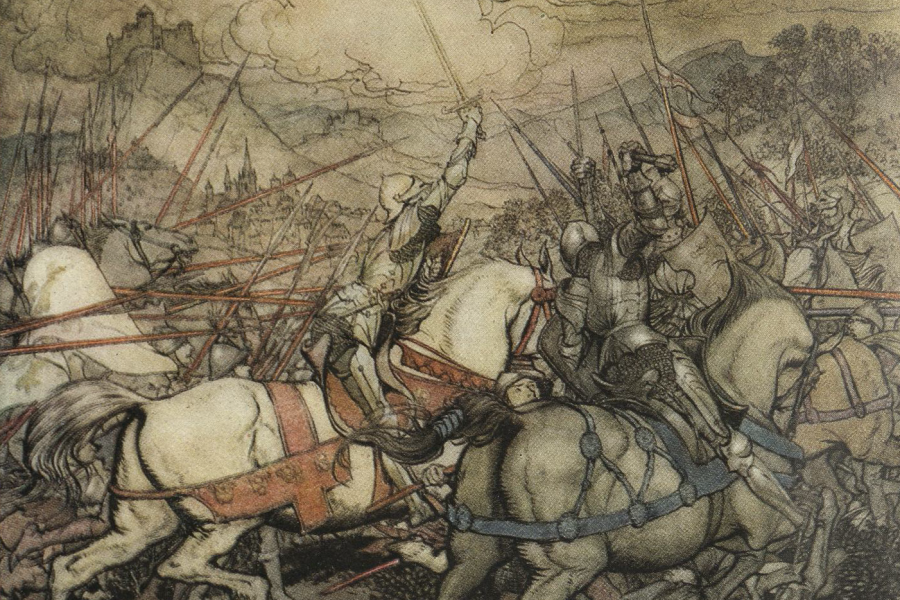
Centre for Arthurian Studies: 5-year celebration and Fellowship fund-raiser
On 8 February this year, Professor P.J.C. Fieldwill be returning to Bangor University to give a keynote lecture, 'Dating the Battle of Badon’at the fifth anniversary of the official launch of the Centre.
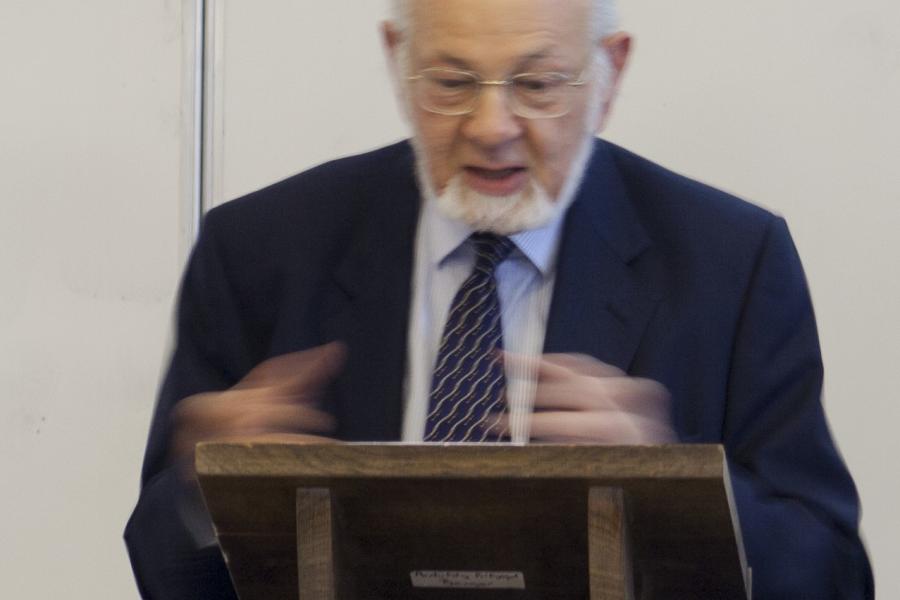
A Tribute to Dr. Roger Simpson by Linda Gowans
Independent scholar and Fellow of the Centre for Arthurian Studies, Linda Gowans, contributes to the memory of Dr. Roger Simpson in her own words.
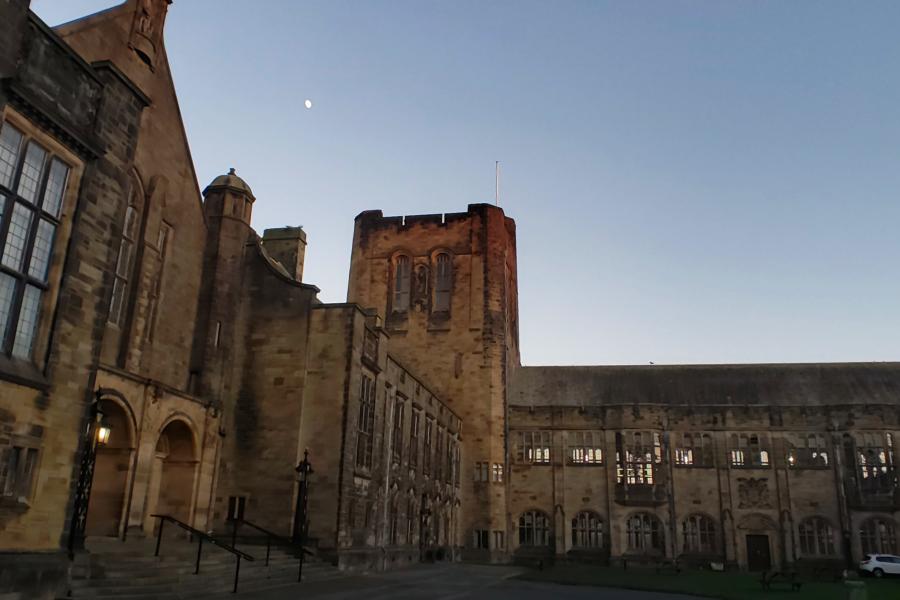
Arthurian Studies at Bangor
The study of the Arthurian legend has been a crucial part of Bangor University's history since its foundation, with Arthurian scholars leading the way in research and public engagement.
Learn more here!

The Green Knight for Our Times: A24 New Movie Reviewed
Apocalyptic post-war imagery, the aura of legend and stunning imagery bring to mind modern warnings of the danger of mass extinction and ecological destruction, while the mysterious presentation of both Gawain and the Green Knight challenge modern audiences to self-scrutinise their own potential naivete about the perils brought about by man’s conquest of nature across centuries of industrialisation.
Centre for Arthurian Studies: 5-year celebration and Fellowship fund-raiser
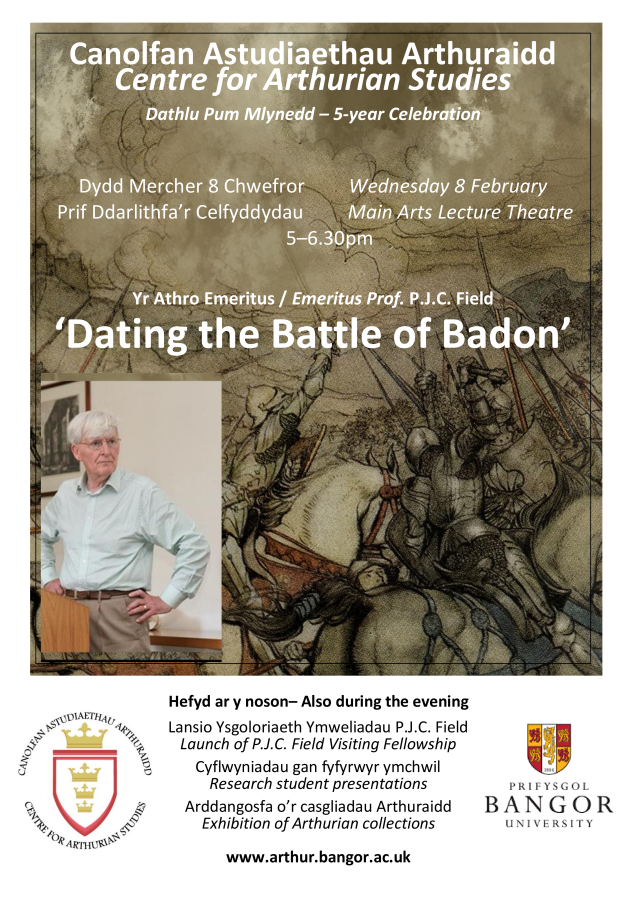
Bangor University's Centre for Arthurian Studies is a hub of international research exchange, bringing together expertise across centuries of Arthurian legends, print and visual media, and theoretical approaches. As such it channels and advances decades of world-leading Arthurian research at Bangor in both Welsh and English. It was launched formally in January 2017 and since then a host of activities, including research, impact and engagement events, have taken place. Some of these are highlighted in our latest newsletter, attached to this invitation.
For our first in-person event after the COVID-19 pandemic, and to mark the fifth anniversary of the Centre, we are inviting you to a relaunch of the Centre, focused around the work of one of Bangor University's leading Arthurian scholars, as well as the work of our current staff and students. From 1964 until his retirement in 2004, Professor P.J.C. Field lectured in the School of English Literature and directed the MA in Arthurian Literature, unique in the world. His 50 years of scholarship on the fifteenth-century romance writer Sir Thomas Malory led to his publishing the first full edition of Malory’s Le Morte Darthurin 2013. Professor Field also served as President of the International Arthurian Society (2002-2005), and has recently performed research to identify the true location of Camelot.
On 8 February this year, Professor P.J.C. Fieldwill be returning to Bangor University to give a keynote lecture, 'Dating the Battle of Badon’at the fifth anniversary of the official launch of the Centre.
At this event we will also be launching the P.J.C. Field Fellowship, a fund established to support visiting researchers who wish to use the Centre’s unparalleled resources and collaborate with our researchers on projects that enhance the visibility and use of our collections.
The event will include the opportunity to view a selection of rare books from our Arthurian collections, in an exhibition specially curated for the event by Prof. Raluca Radulescu, the Centre's co-director, and research posters and presentations by our postgraduate researchers.
Date and time: Wednesday 8 February 2023, 5-6:30pm
Location: MALT (Main Arts Lecture Theatre)
Please register by Thursday 2nd February: Register
A Tribute to Dr. Roger Simpson by Linda Gowans
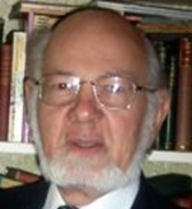
Members have already been sent the obituary for Roger prepared by North American Branch members Alan and Barbara Lupack and Kevin Harty. One of those examples of learning far more about someone from an obituary than you knew in their lifetime, in spite of having been in touch for decades. Roger’s career took in Uganda, East Pakistan, Bahrain, Japan, and until retirement the University of East Anglia.
I want to emphasise his remarkable knowledge of Arthurian material during a period very much less familiar to most of us than the Middle Ages or the high Victorian years. His book Camelot Regained, dealing with 1800 to 1849, probably contains more that is new to all of us than any other single Arthurian publication.
As well as his books, Roger wrote numerous articles on little-known Arthurian topics, and brought his knowledge and positivity to book reviews for which he was the obvious choice. His work was often to be found in the North American Branch’s journal Arthuriana.
He also had an eye for unusual twentieth-century Arthurian references. Some older people (like myself) may remember a rather daunting publication, The Children’s Newspaper, which I avoided at school in the 1950s. However, Roger found a copy from 1940 headlined ‘King Arthur’s Knights are Back Again’, with a cover photo of young men in the RAF: ‘The Knights of the Speeding Plane’.
His book Radio Camelot means a lot to me for two reasons: it was the last Christmas present from my late partner Jim, and it is also very special because I listened to the BBC Home Service from my earliest years. I remember Roger giving a paper during which he mentioned that there had been an Arthurian episode of Round the Horne: he was delighted when at the discussion afterwards I told him that the script had been published. This was in the days when most of the British Branch was strictly medieval, and the look on one person’s face was not one of approval. You can probably guess who.
It’s hard to think that Roger, with his ever-present quiet courtesy and interest, is no longer present to answer questions: I was last in touch with him about my paper for this conference. We send our condolences to his wife Paddy and their son St John, in warm thanks and appreciation for all the years we had the pleasure of knowing Roger.
The Green Knight for our times: A24 new movie reviewed
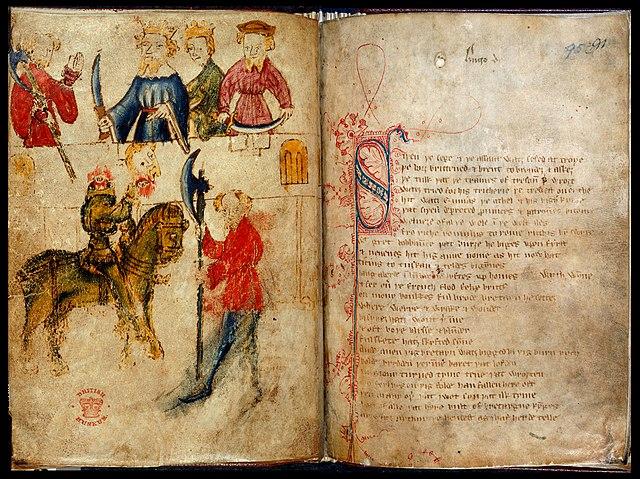
The much-awaited for new A24 Green Knight movie, starring Dev Patel, opened to UK audiences just recently, after a delayed release. Apocalyptic post-war imagery, the aura of legend and stunning imagery bring to mind modern warnings of the danger of mass extinction and ecological destruction, while the mysterious presentation of both Gawain and the Green Knight challenge modern audiences to self-scrutinise their own potential naivete about the perils brought about by man’s conquest of nature across centuries of industrialisation.
The movie is based on the fourteenth-century alliterative poem Sir Gawain and the Green Knight, a gem of medieval English literature that combines anxieties over the performance of chivalry and adherence to moral Christian values against a background of reflections on the passing of time (the backbone of the poem is the calendar year), aging and inner reflection, as opposed to the famed chivalric exploits modern audiences associate Arthurian literature with. The text, likely composed in Cheshire, for a local court, speaks of conflict between the centre (Arthur’s young court) and the border (the Green Knight’s domain), displayed in an opulence of descriptions of material culture, and competing morals presented in each. Both the poem and the movie revel in detail, and it is pleasing to see how the crux of interpretation can easily be said to be in emphasis on the senses: where the written text gives the reader a full sensorial experience, with rich textures, taste, smell and touch (with references to exchanges with Europe and the far East) tempting him/her away from spiritual introspection, the movie pulls the modern audience into enjoyment of Gawain’s sexual trysts and tantalising temptations by Bertilak (aka Green Knight)’s wife.
Interesting choices in the movie are both the aging of the protagonists and the Green Knight’s portrayal. While the fourteenth-century poem depicts Arthur as young, hot-headed, ‘boyish’ (‘childgered’), just like all his other knights, and hence in need of learning from the mature Green Knight, the movie shows where chivalry ends, bringing destruction rather than a fulfilment of ideals, with an aging Arthur and Guenevere, well past the age of prowess on the battlefield or in the bedroom, with scenes of mass destruction – human and nature alike overcome with grief and deceit. Much of the original text and the movie centre around human desire and its repercussions, and although the original poem doesn’t expose man’s conflict with nature in quite the same way as modern audiences perceive it, human ambition and dreams of grandeur and conquest are just what brings down Arthurian chivalry, and modern society. Indeed Gawain is sexually tempted in both versions, yet in the movie the fact he is not a knight yet, and clearly not ready to become one either, enhances the moral of the quest he goes through, watching helplessly the rapid waning world of legend (the giants of lore) and saints’ lives (the novel element in the movie) while his own temptations expose his fragility. The Green Knight himself poses several problematic issues in both texts; in the original text he is human, of huge stature, extraordinarily attired in complex and fashionable clothing befitting a knight of high social standing, yet barefoot and holding a branch of holly and an axe, upsets this seemingly peaceful scene. In the movie, his stature is less important than his tree-like form, which speaks of Tolkien- esque adaptation, ancient forests being destroyed to make human dwellings, serve wars, while his challenge is even more subtle, through his wife showing Gawain is not quite ready to comprehend his mission in the world.
Gawain’s portrayal at the centre of two worlds is fabulously problematic in itself, and it is here that the movie captures the medieval concern with introspection and philosophical concerns. Nature and humanity are not in conflict as such, one might think, not openly, at least, in fourteenth-century thinking or the original poem. However, the encounter with nature speaks of the need to master the turmoil within, and Gawain/Arthur’s court have much to learn from the outside challenger, the Green Knight and his lady. The poem exposes the flaws in Arthurian chivalry, its shallow observance of Christianity, and the dangers of overweening worldly pride. Gawain’s journey through a desolate landscape, seeking to find the Green Chapel where the Green Knight is said to reside, is only a prelude to the exquisite temptations of Bertilak’s (later revealed to be the Green Knight) court and his lady. In much the same way, the movie evocatively sets the scene so that Gawain’s nightmarish foresight of future glory combines destruction and pointless fame in several short, powerful flash images. All of these features bring to the fore not just the way in which both medieval poem and modern movie encourage reflection on nature vs civilisation, but also the perennial danger of vainglory in this world, which here has dazzled Arthur’s court, and modern humanity in believing itself invincible, but led to widespread destruction of the natural world.
17 February 2022
Bangor expert contributes to Arthurian stamp launch
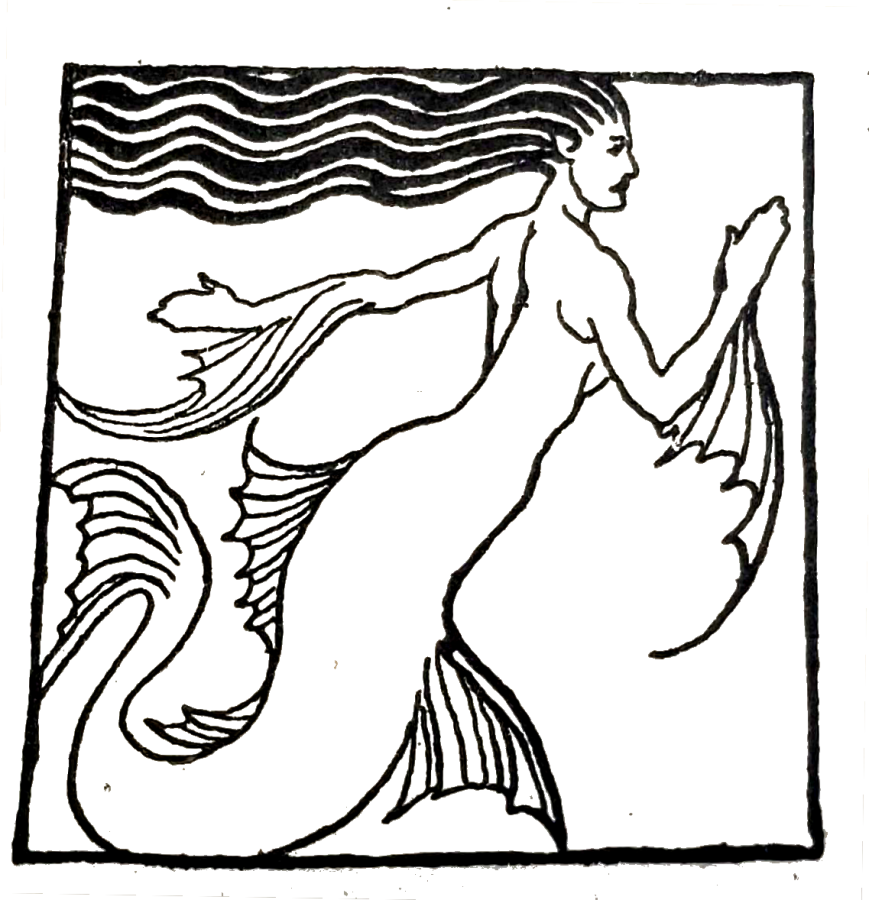
The enduring popularity of the Arthurian legends has been underlined yet again by the new publication of a set of stamps depicting Arthurian legends and characters by the Royal Mail.
The new stamps have designs commissioned from artist Jaime Jones, and the accompanying text is by Bangor University Arthurian expert, Professor Raluca Radulescu.
This new commission of a series of collectible stamps provides ample opportunity to explore the pan-European appeal of the legends in the Middle Ages according to Professor Radulescu.
From the Welsh origins of the Celtic Arthur to the modern interpretations (last year’s Netflix series Cursed, or the forthcoming Sir Gawain and the Green Knight movie, starring Dev Patel), legends continue to inspire authors across the world.
Guinevere, Merlin, the Knights of the Round Table, Sir Lancelot defeating the dragon and Sir Galahad encountering the Holy Grail are all depicted on the stamps.
Professor Raluca Radulescu of the University’s School of Languages, Literatures & Linguistics said:
“Hardly a year goes by without a reworking of the Arthurian legends in a new film or television series.
I am delighted to have contributed the framing introduction to this series of stamps, and the accompanying article in the Royal Mail Yearbook, which will introduce the general public to the multilingual, multi-racial medieval stories, and their importance in both politics and culture across the Middle Ages and beyond’.
A leading international expert on Arthurian Literature, Professor Raluca Radulescu leads the world’s only MA course in Arthurian Studies.
Publication date: 16 March 2021
Centre to host the digitised volumes of the Bibliographical Bulletin of the International Arthurian Society
The Centre is proud to announce that it has been entrusted with hosting the digitised volumes of the Bibliographical Bulletin of the International Arthurian Society (BBIAS), the annual bibliographical and research publication of the society, running continuously since 1949. Bangor PhD student Madeleine Killacky is the project assistant and the project is funded by the IAS.
Publication date: 22 October 2020
Professor Raluca Radulescu, our director, will be giving her workshop on the rare Arthurian books in our collections on 25 March.
Professor Raluca Radulescu, our director, will be giving her workshop on the rare Arthurian books in our collections on 25 March. This event is part of the collaboration initiated by Prof. Radulescu with Elen Simpson, Archivist, part of the ‘Your Archive Week’ series which started in November 2019. Book your place soon, to avoid disappointment.
Publication date: 9 March 2020
International Postgraduate Community in Arthurian Studies launched by Bangor University
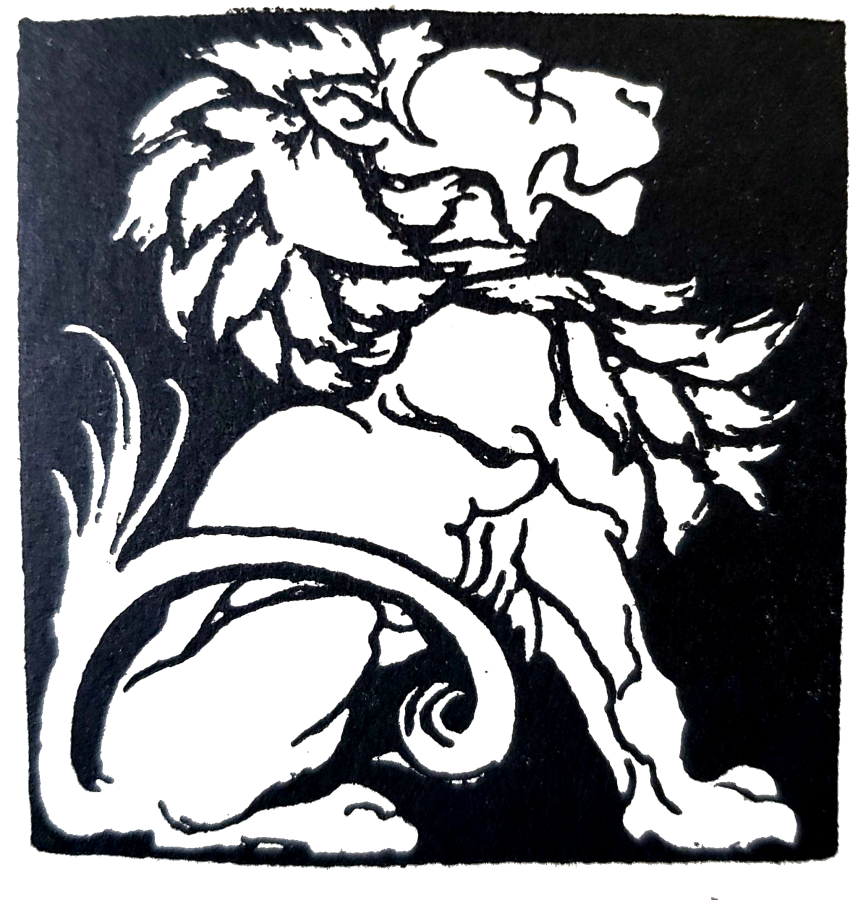
For the first time in its 16-year history, this year’s Medievalism Transformed conference exchanged its beloved ‘College on the Hill’ dwelling for an entirely virtual space in collaboration with the Centre for Arthurian Studies. Over the course of two days (18-19 September 2020), the Centre welcomed over 150 speakers and attendees from all over the world to exchange ideas about ‘Movement through Arthurian Legend’. The conference investigated how texts are re-invented across time, what role texts play in their historical moment and beyond, and how texts engage with moving times, cultures, and spaces. Some highlights included: a panel on ‘Material Movement’, which looked at Arthurian animals on the move as well as the role of cartography in Medieval Welsh texts; a panel on the movement of language through medieval texts; a panel dedicated to the Welsh King Arthur; and various panels on Early Modern and Modern adaptations of the Arthurian legend. The highpoint of the conference was, of course, our keynote speaker, Dr Aisling Byrne who is Lecturer in Medieval English Literature at the University of Reading, and who gave a paper entitled ‘Medieval Arthurian Texts in Motion’. Although the conference had to adjust to an online format following pandemic complications, its online presence attracted a number of scholars from around the world. Presenters from as far away as North America (Yale University, Memorial University, and Western University to name a few) and as close as Bangor University, the University of Oxford, and the University of Edinburgh (again to name but a few) were able to come together for some much enjoyed Arthurian debate. Further, the conference’s online presence welcomed an eclectic medieval audience, which included a number of highly distinguished Arthurian scholars as well as some alumni from the Centre for Arthurian studies. In the face of a global pandemic, this two-day online conference provided a positive encouragement to young medievalists as well as generated some much-needed connection in these troubling times. Further, by virtue of its online format the conference was able to play a part in breaking the barrier between academia and the broader community thereby allowing more people to access and engage with academic knowledge. Overall, this year’s Medievalism Transformed conference was a success and the organisers look forward to welcoming back presenters and attendees in 2021.
Over the next few weeks, as a follow-up to the conference, we will be inviting presenters to contribute their revised abstracts to be published on the Centre for Arthurian Studies website. This will provide a concluding summary to the ideas that developed from this two-day event for those who may have missed the event and for those who wish to re-visit some of the papers presented.
28 October 2020
Digital version of the Bibliographical Bulletin of the International Arthurian Society joins its hardcopy collection at Centre for Arthurian Studies
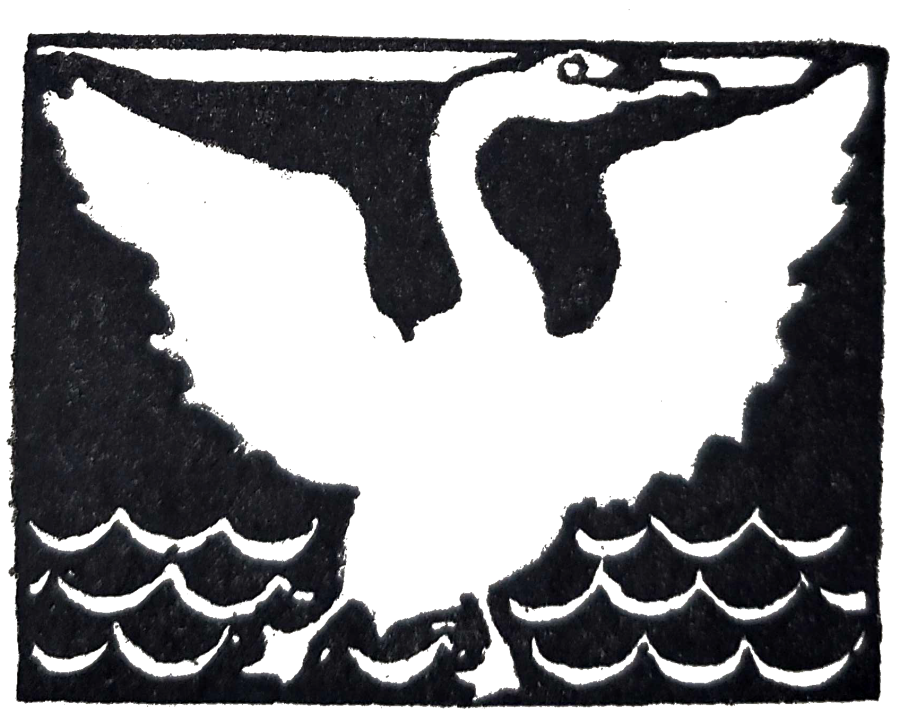
A digital version of the Bibliographical Bulletin of the International Arthurian Society now joins its hardcopy collection in the Centre for Arthurian Studies. The digitalisation of this important resource is hugely important for research students (MA and PhD) at Bangor University as well as for scholars of Arthurian literature around the world. The first Bulletin was published in 1949 and, owing to its limited hard-copy availability, earlier volumes thus far have been difficult to access. The digital collection now means that scholars can access the material quickly, without hinderance, and from all over the world.
Publication date: 29 October 2020
The Romance of Sir Degrevant
‘The Romance of Sir Degrevant’, Printed by William Morris at the Kelmscott Press, Hammersmith, 1896. This is one of only 350 original copies made on paper with 8 copies on vellum. The Frontispiece was designed by Edward Burne-Jones and engraved by W.H. Hooper. The printing type is Chaucer Type printed on hand-made paper which holds the second version of the Primrose watermark.

Much of William Morris’ own writing, its subjects and style were inspired by his love of medieval literature. These could be found in the illustrated manuscripts and printed tomes of Early Modern Europe. Not surprising therefore that he chose to publish this tale. Sire Degrevaunt is a medieval romance composed circa 1440. It survives in two manuscript versions; MS 91 at the Lincoln Cathedral Library (a collection of texts assembled by Robert Thornton) and Ff.i.6 at Cambridge University Library (an anthology compiled by the Findern family of Derbyshire and their friends)
This Middle English romance much admired for its realism and plot is written in the form of a tail-rhyme stanza. The love story follows the endeavours of a young knight Degrevant, to prove that he is worthy of the hand of his beloved Melidor, the daughter of a neighbouring Earl, whom he has fallen out with over a dispute on hunting. The indifferent maid rejects the young knight’s initial approaches and Degrevant is obliged to seek the help of her lady's maid who has romantic designs on his squire. However, in the meantime the Earl pledges his daughters' hand to the Duke of Gerle who arranges a tournament in Melidor’s honour at which he intends to slay his rival in love. Unfortunately for Duke Gerle, Degrevant twice unhorses him, much to the merriment of Melidor whose mockery leads to the Dukes humiliated departure. Degrevant uses a secret entrance, previously shown him by the maid, to gain access to Melido’r chamber at which point she admits her love for him and they plight their troths but she refuses to consummate the relationship until after their marriage.
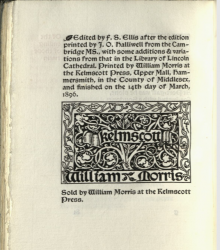
For nine months the young knight courts his love by visiting her chambers every night until their assignation is discovered. This leads to a bloody battle with losses of life on both sides. The enraged Earl is eventually persuaded by his wife the Countess to allow the marriage which sees the Knight and the Earl reconciled and leads to the star-crossed lover’s happy ending.
This hand-crafted book created as an artistic rather than a commercial endeavour by William Morris at his Kelmscott Press was produced in small runs making it a coveted collector's item. The Kelmscotte Press was the most famous and celebrated of the private presses. The term "private press" is often used to refer to a movement in book production which flourished around the turn of the 20th century under the influence of the scholar-artisans William Morris, Sir Emery Walker and their followers. The movement is often considered to have begun with the founding of William Morris' Kelmscott Press in 1890, following a lecture on printing given by Walker at the Arts and Crafts Exhibition Society in November 1888. The mainstay of the movement concerned a return to creating books by traditional printing and binding methods, with an emphasis on the book as a work of art on the manual skill involved in their production. A departure from the cheap mass-produced books of the industrial revolution. Morris was greatly influenced by medieval printed books and the 'Kelmscott style' influenced later private presses. The books were made with high-quality materials (handmade paper, traditional inks and, in some cases, specially designed typefaces), and were often bound by hand.
This copy is part of the Flintshire Harries Collection which can be found in the Centre for Arthurian Studies at the Main Library.
By Shan Robinson s.a.robinson@bangor.ac.uk
22 October 2020
Bangor University Arthurian PhD alumni publish new book
The Horse in Premodern European Culture: why horse history matters for Arthurian scholars
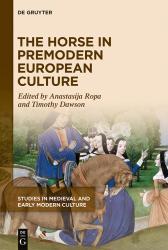
In 2014, I went to the International Medieval Congress in Leeds, with a paper about a minor female character of Arthurian romance, King Solomon’s wife in the Queste del Saint Graal. It was a spin-off one of the chapters in my recently completed doctoral thesis and the first paper I was going to present as a doctor. I was at a loss at what I would be doing next. I had a well-paid job outside the academe, and little idea what to do next in terms of research – or whether I will be able to do any research at all in future.
I did not know it then, but meeting Timothy Dawson at one of the IMC receptions was to be a turning point in my career. An Arthurian scholar and a Byzantinist – what could we talk about? It turned out we had one interest in common: horse history. We agreed that knowing about horse history is essential for any medievalist, because horses were an integral part of medieval life, yet there seemed few recent studies and little interest in medieval equestrian history back then. Ann Hyland’s books were out of date and criticized due to her lack of academic background. Yet there was nothing to replace her comprehensive studies of the medieval horse for a medievalist who wanted a general introduction to the theme.
We decided to counter this challenge by proposing a session on horse history at the next. Actually, with the responses we received to our call for papers, we have been able to organize three interdisciplinary sessions on medieval equestrianism in 2015 and four sessions in 2016. What is more, when I went to Kalamazoo in 2016, I met with Dr Simon Forde, director of the Arc Humanities Press, who suggested publishing a book about the horse in medieval Europe. I did not feel qualified or experienced enough to write a monograph about medieval horses back then, so I proposed an edited volume based mostly on the IMC contributions.
It took me and Timothy nearly four years to complete the book, which is, I believe, good timing, given that it was an innovative venture in English medieval scholarship and the fact the contributions spanned a variety of time periods, regions and disciplines.
We had amazing authors, one of whom was Elina Cotterill, who, like me, has studied Arthurian literature in Bangor University and had Prof Raluca Radulescu as her supervisor. I was thrilled when Elina accepted my invitation to present a paper at the IMC and offered to speak about hippiatric treatises, an important but complicated issue in medieval equestrian history. Elina explained that to me that her interest in hippiatric remedies stems from the early days of her Bangor MPhil, when she started to look at the medieval equestrian context for the Morte D'arthur and discovered a number of hippiatric treatises. She could not dive into these in depth until some years after graduating. Being now based in Oxford, she had all the resources needed to complete such a study, and her article is well-informed, easy to read and fascinating both for literature scholars and for those who are primarily interested in horse history.
Working on the book, we had the good fortune to meet scholars coming from all kinds of backgrounds, some of whom were in early stages of their career, while others were more experienced. I could not believe my eyes when we have received a paper from John Clark, the editor of The Medieval Horse and Its Equipment c. 1150-1450, which is the key book on medieval equestrian history ever since its publication in 1995. Our book included contributions by non-native speakers of English and by those with little experience of writing for academic publication, and several authors were so generous with their time as to review other authors’ papers. John Clark and Elina Cotterill were among the volunteers, and I am very grateful for the commentary on the language and content our author-reviewers have offered.
I hope that our volume would be useful to a wide range of scholars, including Arthurians, because knowing about medieval horses is important for anyone who wants to understand the place of the horse in medieval romance. Moreover, two articles in the volume refer to Arthurian text. The article by Miriam Bibby traces the story of Scottish horses starting from Guillaume le Clerc’s romance of Fregus, where the hero’s horse is presented as an outstanding representative of its type. In my own article about the price and value of the medieval warhorse, I discuss examples from several Arthurian romances, including Sir Gawain and the Green Knight, La Queste del Saint Graal and Thomas Malory’s Le Mort Darthur. Both Miriam’s and my own article are informed by the belief that not only can the study of equestrian history enhance our understanding of Arthurian romance, but also an informed reading of horse-related episodes in Arthurian romance can contribute to our understanding of equine history.
About the book: This volume features approaches to equine studies from disciplines as diverse as archaeology, legal, economic and military history, urban and rural history, art and literature. This volume explores the ubiquitous – and often ambiguous – role of the horse in medieval culture, where it was simultaneously a treasured animal and a means of transport, a military machine and a loyal companion. The contributors, many of whom have practical knowledge of horses, are drawn from established and budding scholars working in their areas of expertise.
About one of the authors: Anastasija Ropa holds a PhD from Bangor University, UK. She is the author of Practical Horsemanship in Medieval Arthurian Romance (Trivent, 2019) and editor of the Rewriting Equestrian History published by Trivent. Currently, she is lecturer at the Latvian Academy of Sport Education, Department of Management and Communication Science.
Publication date: 16 July 2020
New P.J.C.Field fund to be established
Following the annual meeting of the external board of the Centre, we are happy to announce a new P.J.C.Field fund will be established, to provide support for visiting research fellows of the Centre. More details to be published here soon.
Publication date: 9 December 2019
Bangor Fund will enable us to organise research training
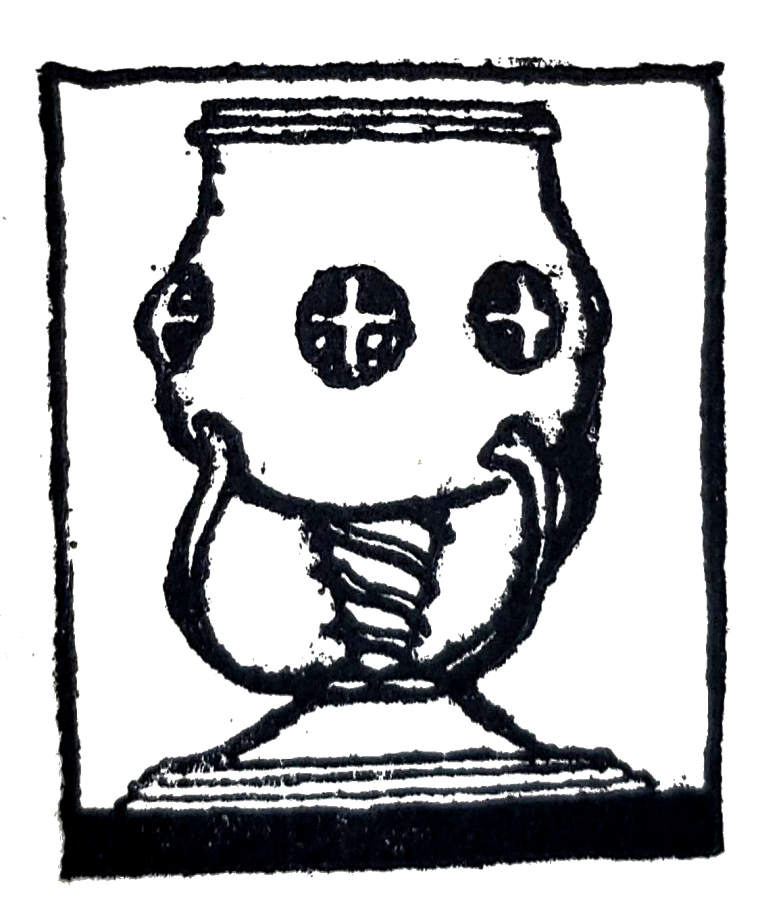
A generous award from the Bangor Fund will enable us to organise research training for our postgraduate MA and PhD students at our partners, the National Library of Wales and the John Rylands Library, Manchester. Watch this space for updates!
Publication date: 4 November 2019
Quest 2019
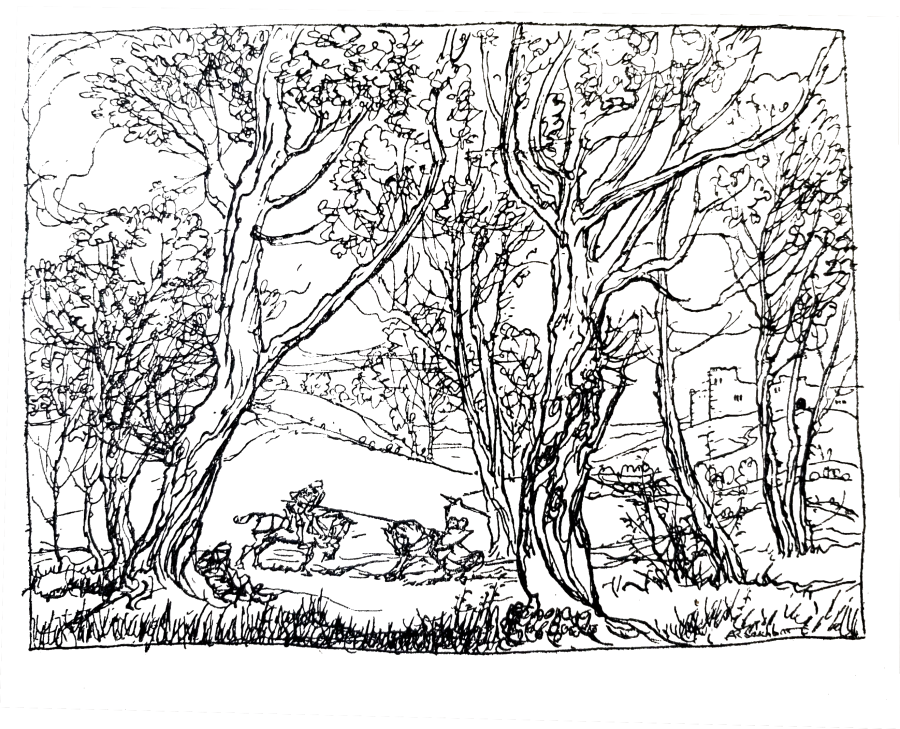
Building on a successful pilot project, which saw pupils enjoying Arthurian literature and creating their own modern ‘Arthurian’ quests, the Centre for Arthurian Studies at Bangor University are sharing what they’ve learnt with primary and secondary school teachers today (5th of July 2019).
The new event shares the key actions from last year’s “Quest”/ “Ymgais” literacy project. Professor Raluca Radulescu, the Centre’s Co-Director worked with Gillian Brownson, a writer, storyteller and Community Theatre Practitioner and Kate Stuart, PhD student in media studies, to inspire local school children on a number of Arthurian-themed interactive activities.
The pupils came to understand how some of the enduring themes of Arthurian literature can be found in today’s popular media. They took part in interactive storytelling, theatre games, writing workshops and video diaries.
Professor Raluca Radulescu, and Gillian Brownson will be sharing how to use the myths and legends represented in the University’s collection in the classroom.
Prof Radulescu explained:
“It’s been our dream to develop the principles behind our project into a resource that can be used by all the schools in North Wales and further afield, across the UK and in the world. Interest in our school events and how our research is translated into impact on society has attracted the attention of journalists and documentary-makers from Japan to the US and, most recently, Russia. Our aim at the Centre for Arthurian Studies is to attract international researchers to share our resources and promote research exchanges in this relevant field of study, and also ensure that the Centre is open to as many people as possible in the local community.”
The Quest For Successful Futures: Myth and Arthurian Legend in the Classroom workshop includes:
• A visit to the Centre for Arthurian Studies and Bangor University’s Archive, with a one-of-a-kind opportunity to handle rare books and manuscripts
• A demonstration of Arthurian-themed interactive activities to use with students and one-to-one advice on how to put those activities into practice
• Expert talks on the Centre’s resources from Raluca Radulescu, and on the benefits of storytelling for all ages from Gillian Brownson
The Centre for Arthurian Studies has access to an unrivalled collection of publications, including rare editions in Arthurian studies; the collections have been enhanced through private donations, which started even before the University Library was established, and have continued to grow through the dedicated work of Bangor scholars and librarians' careful preservation of the stock.
The Quest project was funded by the Bangor University ESRC Impact Acceleration Account.
For more information, see Arthur.bangor.ac.uk
Publication date: 5 July 2019
Blog: Launch of 'Arthur in the Celtic Languages'
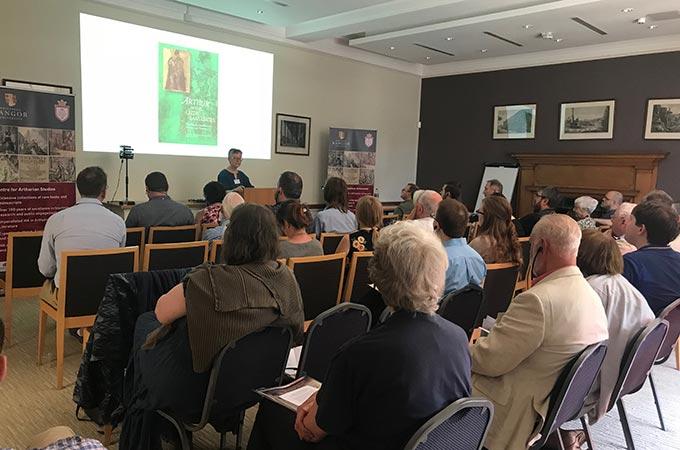
A very successful and well-attended event was held on 28 February 2019 in the Council Chamber, Bangor University, to celebrate the recent publication of Arthur in the Celtic Languages. The Arthurian Legend in Celtic Literature and Traditions (University of Wales Press), co-edited by Dr Ceridwen Lloyd-Morgan FLSW, Honorary Research Fellow and member of the Centre for Arthurian Studies at Bangor University, and Professor Erich Poppe, recently retired from the Chair of Celtic Studies at Philipps-Universität, Marburg, Germany. The event was held under the aegis of Bangor University’s Centre for Arthurian Studies, at the kind invitation of its Founding Director, Professor Raluca L. Radulescu FLSW. It highlighted the long tradition in Arthurian and Celtic studies at Bangor since the inception of the University and its library in 1884, and, more recently, the ‘Arthurian Legends in Wales and Beyond’ symposium held in June 2018, and the forthcoming XVI International Congress of Celtic Studies, to be held 22–26 July 2019.
After words of welcome, in English and Welsh, from Professor Radulescu and the Centre’s Deputy Director, Dr Aled Llion Jones, Dr Lloyd-Morgan introduced the two guest speakers. Professor Poppe’s groundbreaking paper focused on emotion in the the Middle Welsh Arthurian tale of Owain and its counterparts in French, English and the Scandinavian languages, while Professor Sioned M. Davies FLSW, of the School of Welsh, Cardiff University, drawing on the empirical research of a distinguished Bangor scholar, the late Dr Constance Bullock-Davies, outlined a completely new approach to another mediaeval Welsh text, Breuddwyd Rhonabwy.
Covering texts and traditions in all the Celtic languages from the Middle Ages to the 20th century, and with contributors from Wales, Scotland, Ireland, England, Germany, Brittany and the USA, Arthur in the Celtic Languages exemplifies the essentially international, multilingual and co-operative nature of scholarly endeavour; this was further underlined by the number of languages spoken by attendees networking over refreshments. The event was attended by many Fellows of the Society, a number of them from other disciplines, including Professor Alan Shore FLSW, Professor of Electrical Engineering at Bangor University and General Secretary of the LSW. We are most grateful to them and to the Society for supporting this events.
Live streaming of the talks led to an international audience through online broadcast, and the recordings are now available on the Centre’s website.
Publication date: 27 June 2019
Quest 2019
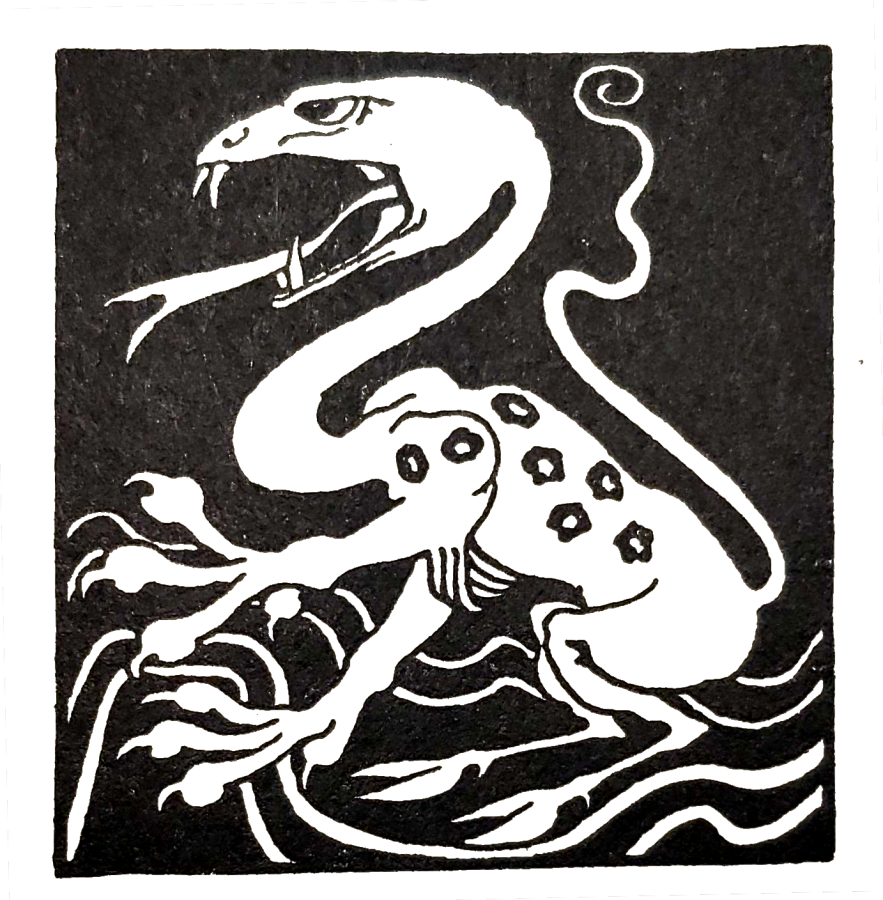
On the 5th of July 2019, the Centre will be hosting a workshop for primary and secondary school teachers. Open to teachers across North Wales, this new event will build on the success of last year’s “Quest”/ “Hymgais” literacy project and will allow teachers to come to the Centre experience our magnificent collection of rare books and manuscripts, and to attend talks held by Professor Raluca Radulescu, Director of the Centre, and Gillian Brownson, writer and storyteller, on using the myths and legends represented in our collection in the classroom.
The Centre’s dream team of Raluca Radulescu and Gillian Brownson organised the highly successful Quest literacy project last year and have been keen to develop the principles behind it into a resource not limited to the students of one school, but into one that can be used by all the schools in North Wales. Their enthusiasm for Arthurian legends and drive to open the Centre to as many people as possible has resulted in a free Continuous Professional Development workshop aimed at primary and secondary school teachers entitled Quest For Successful Futures: Myth and Arthurian Legend in the Classroom.
The workshop will include:
• A visit to the Centre for Arthurian Studies and Bangor University’s Archive, with a one-of-a-kind opportunity to handle rare books and manuscripts
• A demonstration of Arthurian-themed interactive activities to use with students and one-to-one advice on how to put those activities into practice
• Expert talks on the Centre’s resources from Raluca Radulescu, and on the benefits of storytelling for all ages from Gillian Brownson
The event is to be held on the 5thof July at Bangor University, in two sessions:
10:30-12:30 for primary school teachers.
1:30-3:30 for secondary school teachers.
This CPD event will be held in English.
Publication date: 29 May 2019
Exposing Arthur’s Celtic roots
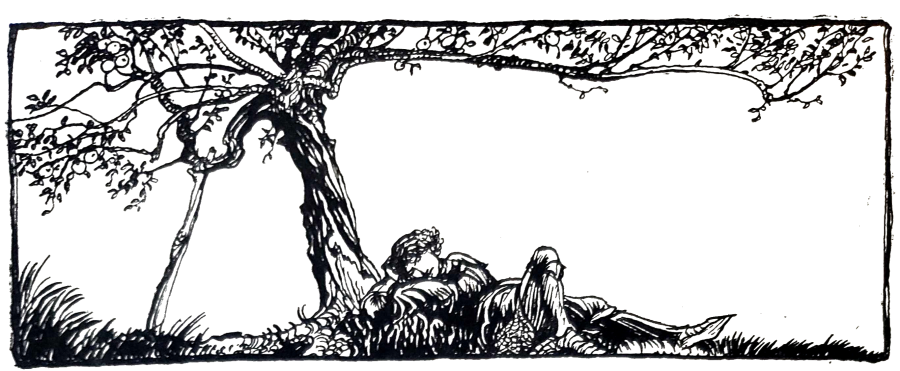
Despite recent interpretations giving Arthur English, French or cockney accents, a new academic book launched today (28 February) at Bangor University firmly plants him in the Celtic lands and Celtic languages.
Arthur in the Celtic Languages, The Arthurian Legend in Celtic Literatures and Traditions, is published by the University of Wales Press and edited by Ceridwen Lloyd-Morgan, an Honorary Research Fellow at Bangor University. This is the first volume to present a comprehensive authoritative survey of Arthurian literature and traditions in the Celtic languages of Welsh, Cornish, Breton, Irish and Scottish Gaelic.
The launch is hosted by Bangor University’s Centre for Arthurian Studies, a hub for international research in Arthurian Studies, and follows a symposium on the same topic held at Bangor University last year.
Professor Raluca Radulescu, Director of the Centre commented:
“This is a book that will change thinking on this topic for a generation; no such volume has ever tackled all medieval and modern retellings of Arthurian legends in all the Celtic languages. The chapters tackle the most recent scholarly debates on the topic, and open up new avenues for research in Celtic Arthurian studies.
“That’s why we’re particularly delighted to host the launch of this important volume."
“This volume will be a vital resource for any student of the Celtic Arthurian stories. It provides new insights into how the figure of Arthur evolved from the leader of a warband in early medieval north Britain to a king whose court becomes the starting-point for knightly adventures. It also covers how characters and tales have been reimagined, reshaped and reinterpreted over the centuries, up to the present day.”
Dr Aled Llion Jones, of Bangor’s School of Welsh and Celtic Studies added:
“This new book gives us a unique opportunity to see how these important early Welsh legends became the currency of all the Celtic languages.”
Bangor University has a long-standing link to Arthurian studies in the Celtic languages, and offers rare postgraduate degree opportunities to study world-wide Arthurian literature. Boasting unrivalled resources, including many rare books and manuscripts, the Centre for Arthurian Studies has hosted over 200 international and national research visits by students and international researchers.
Publication date: 28 February 2019
Prof. Raluca Radulescu has been invited to deliver a presentation at the AMARC (Association for Archives and Manuscripts in Research Collections) day symposium
Prof. Raluca Radulescu has been invited to deliver a presentation at the AMARC (Association for Archives and Manuscripts in Research Collections) day symposium at the Bodleian Library, Oxford, on the topic of research impact and engagement activities around the Arthurian collections at Bangor University Library Archives and Special Collections and the Centre for Arthurian Studies. The event, attended by 40 participants, brought together archivists, curators and librarians, as well as academics, from institutions across the UK.
Publication date: 22 October 2019
Libraries in the snow: three weeks at the Centre for Arthurian Studies
In February and March of 2018, I spent three weeks at the Bangor University, working on, a work containing editions of Gildas and Nennius, and Bertram's forgery of an itinerary by Richard of Cirencester. This is the story of how that went.
View from Centre for Arthurian Studies
Originally, I had a cunning plan: I would leave Sweden in the throes of late winter weather, and go to Wales, so that in between reading and writing I could enjoy the early spring, with daffodils. This initially worked well: I got a warm welcome from my colleagues at Bangor, and settled in very happily to a routine that would end up producing more text in three weeks than I think I have ever been able to write in such a short time.
Every day, I would arrive on the morning bus - having chosen to stay outside town - and go to the manuscript room to spend the morning working on Bertram's Latin text. Reading and transcribing Latin is, I find, work that requires a fresh mind, not a post-lunch lethargic one. The difficulty with Bertram's text is access to the map he created: to my great joy, a minor administrative fee got me a whole day of photographing it from every conceivable angle. As the map, folded into the book, was very fragile, I preferred to unfold it only once rather than working directly from it every day. The map had a significant impact on 18th and 19th c views on the Roman history of Britain, and is indispensable for any serious study of Bertram's work.
In the afternoon, I would go up to the Centre high up in the tower, open the window to the spectacular view over Bangor, and guiltily browse the shelves for a bit before settling down to work. Even though the Flintshire Harries Arthurian Collection proved to be a temptation to take breaks, I would loop my laptop cord over the sword in the stone prop, and then I would write.
College Park, Bangor University
It turns out that the library, in addition to possessing a copy of Britannicarum Gentium Historiæ Antiquæ Scriptores Tres, provides access to digitalised 18th and 19th century magazines such as The Gentleman's Magazine, The Antiquary, and British Critic, which enabled me to track the whole discussion of Bertram's text for the first hundred years after its publication. I accessed over fifty texts, from long discussions of the text's qualities and veracity to brief letters to the editor, and this made it possible to finish my chapter on the reception of Bertram's work. During the weeks at the Centre I ended up writing 20, 000 words. I also got started on a paper on Bertram's two editions of Nennius, which I read at the Centre's symposium "Arthurian Legends in Wales and Beyond," in June. In between writing bouts, I had opportunities to discuss my work with knowledgeable colleagues over tea. All in all, my stay at the Centre for Arthurian Studies supported my work to an extent I find it hard to believe I could have got elsewhere.
Of course, the rest of my cunning plan did not work out so well. A few days into my stay we had unexpected snow, with no water at my airbnb, and the daffodils entirely under the weather, so to speak. Once I got home, I discovered that this was one of those years that the Swedish winter decides to last into April, and that climbing over a mountain of snow to get to my front door might be something I'm getting a little too old for. Nevertheless, I brought with me new insights, a finished chapter, and the pleasure of interacting with colleagues in my own field. Surely scholars have endured more for less.
Dr. Kristina Hildebrand, Halmstad University
Publication date: 7 February 2019
How I chose to do the MA in Arthurian Literature at Bangor University
A blog post by Sean Ferguson, MA in Arthurian Literature student, 2017-18.
It was at the University of Florida (Gainesville) where my passion for Arthuriana began. I majored in English and minored in Medieval & Early Modern Studies (MEMS), and part of this work involved a module called ‘Tales of King Arthur’ taught by Dr Judy Shoaf. While Shoaf’s entire module was brilliant, her sessions on Malory and later the Grail Quest—a translation of the Lancelot-Grail cycle—were among my favorites. In these sessions, we unpacked these texts and looked at several issues surrounding them, including politics, spirituality, and the evolution and endurance of the Arthurian legend.
Since arriving at Bangor University, I have immersed myself not only in Arthurian scholarship, but also the field of Medieval Studies in general via IMEMS seminars and public events put on by the School of English Literature. Bangor’s Centre for Arthurian Studies holds an unmatched collection of both primary and secondary sources on Arthuriana, and having access to this collection as part of my research has been enriching on multiple levels. Some highlights of the MA programme include working with Bangor’s world-leading faculty, including Prof Raluca Radulescu and Emeritus Professor PJC Field, library trips to Manchester and Aberystwyth where students can see first-hand some of the precious texts studied on modules (most notably editions of Geoffrey of Monmouth and Malory), and the flexibility of the course in terms of elective modules.
The MA in Arthurian Literature at Bangor is a unique and exciting course, and I look forward to continuing my journey on this once-in-a-lifetime opportunity.
Publication date: 9 August 2018
Beardsley Malory
Beardsley Malory's book cover at Bangor University Book Store.
Book title:
Sir Thomas Malory. Le Morte DArthur. J. M. Dent & Co: London, 1893-4.
Illustrated by Aubrey Beardsley.
On Tuesday 26th July 2016, Dr Samantha Rayner (UCL) and I visited a place of wonder: a book storage unit. Tucked away on an industrial estate in North Wales, this enormous warehouse is home to thousands of titles belonging to Bangor University – books that, for a variety of reasons are no longer held in the main university library – whether due to changing syllabi, modernised editions replacing older ones, or shifting fashions for certain areas of study. The books that have been removed to this unit represent a very real issue for libraries with regard to storing materials that make way for more current titles and collections, but they also make for a veritable treasure trove of almost forgotten material for bibliophiles – as we were to discover.
Browsing through the shelves – all of which contain uncatalogued materials – Dr Rayner and I discovered some gems, the brightest of which was a beautiful edition of Sir Thomas Malory’s Le Morte D’Arthur – illustrated by Aubrey Beardsley (b. 1872, d. 1898), published between 1893-4. This is an iconic work for Arthurian, Victorian, publishing, and art historian scholars alike.
According to the art critic Haldane Macfall, a fortuitous encounter in a Cheapside bookshop between would-be artist Aubrey Beardsley (b. 1872, d. 1898) and publisher John M. Dent resulted in this work – one of the most sumptuous and iconic editions of Sir Thomas Malory’s Le Morte D’Arthur of the Victorian Arthurian Revival, and indeed of modern times.
Beardsley, who worked as an insurance clerk in London, frequented the nearby Jones and Evans’ bookshop on Queen Street. He befriended one of the owners, Frederick Evans, to whom he would show his drawings. In 1892 the publisher Dent was also in the bookshop, and told Evans about his search for an innovative artist to illustrate a new publishing venture.
Dent had decided to produce an edition of Malory’s Arthurian masterpiece, the Le Morte D’Arthur, in his aim of publishing beautiful yet affordable classics to rival the expensive editions produced by William Morris’ Kelmscott Press. The story goes that Dent was telling Frederick Evans about this when Beardsley happened to enter the bookshop. “There’s your man!” said Evans.
After offering a sample illustration, to which Dent responded enthusiastically, Beardsley produced nearly 500 black-and-white drawings for the book. Some were fairly radical – vastly different to representations of Arthuriana that had come before:
…some of the full-page illustrations, such as “The Lady of the Lake Instructing Arthur About Excalibur” conform to standards typical
of the Arthurian Revival, others subvert that standard through
nudity, androgyny, and violence. More often than not, Beardsley
stripped the heroes of their strength and nobility, presenting them reclining, sleeping, or dominated by women.
(The Arthurian Handbook, pp. 241-42)
The book was published with a limited print run of 1,800 copies – with 300 printed on Dutch handmade paper, and 1,500 ordinary copies – the copy we found is one of the latter.
This was Beardsley’s first commissioned work as an artist. It allowed him to leave his insurance role to pursue his artistic talents, and he went on to become an important figure in the Art Nouveau movement. He died of tuberculosis in 1898, just four years after completing the illustrations for Dent’s Le Morte D’Arthur, which is still one of the most iconic and recognisable Arthurian editions of the modern period.
Rebecca Lyons, Bristol University, Bangor alumna and Centre for Arthurian Studies fellow
Update: the Centre for Arthurian Studies and Special Collections at Bangor University Library and Archives are currently working together to raise awareness of the rich and sometimes untapped resources in this location, as well as repair damaged books, such as the Beardsley Malory discussed above.
Notes and Further Reading:
The information here is indebted to another beautiful book held in the E. R. Harries Arthurian Collection:
Haldane Macfall. Aubrey Beardsley: The Man and His Work. John Lane and the Bodley Head Limited: London, 1928.
See also The Arthurian Handbook, 2nd ed. Eds Norris J. Lacy, Geoffrey Ashe, Debra N. Mancoff (Routledge: New York and Abingdon, 2013), pp. 240-243.
Publication date: 9 August 2018
Day symposium: 'Arthurian Legends in Wales and Beyond'

Building on a portfolio of long-standing international research collaboration, and sponsored by IMEMS (Institute for Medieval and Early Modern Studies, Bangor University and Aberystwyth University), the Centre for Arthurian Studies’ day symposium, ‘Chwedlau Arthur yng Nghymru a thu Hwnt / Arthurian Legends in Wales and Beyond’, took place on Thursday 28 June 2018. The theme of the symposium was reflected both in the broad geographical, multilingual, and period framework for the development of the Arthur legends, and in the participants’ international affiliations. The research focus of the event was anchored in the Welsh Arthurian traditions, and the conference proceeded mainly chronologically, beginning with a panel focusing on the medieval Welsh tradition.
Dr Owain Jones (Bangor University) opened the day by considering how an early vernacular chronicle provides insights into the understanding of, and use of, legendary Arthuriana: ‘Y Gorffennol Arthuraidd yng Ngwynedd y drydedd ganrif ar ddeg/ The Arthurian past in thirteenth-century Gwynedd’. Prof. Barry Lewis’ (DIAS) then gave a detailed study of the complex ways in which ‘Arthurian’ elements feature in the imagery and tropology of medieval poetry across a number of genres, in ‘Byd Arthur fel delfryd yng ngwaith y beirdd canoloesol / The Arthurian world as an ideal in medieval Welsh poetry’. Closing the session, Dr Simon Rodway (Aberystwyth University) dived into the prehistory of the ‘oldest’ Arthurian tale, considering its relationship with orality, mythology, literacy and history; his ‘Golwg ar ddatblygiad Culhwch ac Olwen / Exploring the development of Culhwch ac Olwen’, aimed to dispel a number of misunderstandings, including the ‘myth’ that this tale is a ‘myth’.
The first part of the symposium thus brought together contributors to the forthcoming University of Wales Press volume Arthur of the Celtic Languages, co-edited by long-standing member of the Centre (and honorary fellow of the Institute for Medieval and Early Modern Studies), Dr Ceridwen Lloyd-Morgan, with Prof. Erich Poppe. In her keynote lecture, Dr Lloyd-Morgan (formerly Director of Manuscripts and Images at the National Library of Wales) took a comprehensive view of the growth and spread of Arthur’s appeal across the Celtic languages in general: ‘Arthur yr Ynysoedd a'r Cyfandir: Edrych eto ar lenyddiaeth a thraddodiadau Arthuraidd yn yr ieithoedd Celtaidd / Insular and Continental Arthurs: Revisiting Arthurian literature and traditions in the Celtic languages’ was a rich and wide-ranging tour of Arthurian texts and scholarship, placing much of the day’s work in essential context.
The afternoon provided an opportunity to open up research avenues into the twelfth-century best-selling Historia regum Britanniae, in which Geoffrey of Monmouth presented Arthur as a king – and ‘international superstar’. Metaphorical genealogy in the Historia formed the subject of Bangor University PhD student Audrey Martin’s presentation, ‘The heroic family tree of the Historia Regum Britanniae’. Arthur’s trajectory was then traced through the centuries in another medieval best-seller, the fifteenth-century English language compendium of the rise, life and death of Arthur and his Round Table fellowship in Thomas Malory’s Le Morte Darthur; this was presented by Emeritus Prof. P. J. C. Field, one of Bangor University’s leading scholars in Arthurian studies over the past 50 years, and formerly president of the International Arthurian Society (http://www.internationalarthuriansociety.com). The second panel of the symposium concluded with another presentation by a Bangor University PhD student, Ashley Walchester-Bailes (funded by the prestigious Drapers’ Company Scholarship, and one of the first PhD students to be formally associated with the Centre for Arthurian Studies); his project encompasses the revival of authorship and the making of modern editions of Malory’s Morte, and he presented ‘Malory’s ‘great raft’: Edward Strachey and the Morte Darthur’.
The third and final panel of the symposium brought together papers arising from recent research on post-medieval Arthurian traditions. Dr Kristina Hildebrand (Halmstad University, Sweden) a recent visiting research fellow of the Centre, discussed the work of the eighteenth-century author, Charles Bertram: ‘Bertram and Nennius: sources, editions, forgeries’, while Prof. Sioned Davies (Cardiff University) presented a fascinating paper on illustrations to Charlotte Guest’s translations of the Mabinogion in rare early editions: ‘“A most venerable ruin”: word, image and ideology in Guest’s Geraint’. The symposium ended with Scott Lloyd (RCHMW; member of the Centre) presenting a paper on the relationships between popular and academic approaches to the Arthurian legends: ‘Academic vs. popular: the relationship between two different views of King Arthur and Wales’.
Several papers presented at the event drew both on rare materials from the Centre’s Arthurian collections and records from the Archives of the International Arthurian Society, now placed in the custody of the Centre. Attended by over forty staff, students and affiliated members of the community, the symposium paves the way to further scholarly exchanges and engagement with key topics of interest in Arthurian and Celtic studies.
The co-organisers, Centre’s director, Prof. Raluca Radulescu, and deputy director, Dr Aled Llion Jones, would like to thank Shan Robinson, Bangor University Library and Special Collections officer, for her invaluable collaboration and support, the administrative staff in the College of Arts and Humanities, and Chris Drew, manager of the Strategic Alliance (IMEMS), for assistance in making this event a success.
If you are interested in finding out more about the Centre’s planned future activities, please register on our ‘Join our mailing list’ page.
Symposium programme
Publication date: 16 July 2018
Pupils take on Arthurian Quest

With the participating Ysgol Aberconwy ‘questers’ are Gillian Brownson, Richard Burrows and prof Raluca Radulescu.Pupils from Ysgol Aberconwy have been on an ‘Arthurian’ quest to investigate story-telling.
Inspired by Wales’ ‘Year of Legends’, Ymgais 2018 Quest, a project by Bangor University’s Centre for Arthurian Studies, invited a selected number of pupils aged 11-13 to develop modern digital storytelling adventures.
The group from Ysgol Aberconwy have been working both at their School and visiting Bangor University over eight weeks to explore legends and quests through different ways of storytelling and the different media that can be used to tell a story.
While visiting Bangor University the pupils met with Professor Raluca Radulescu of the University’s School of English, an expert in Arthurian literature, who introduced the pupils to some of the Arthurian legends. They also visited the University’s magnificent medieval manuscripts and rare books in the Library’s Archive and Special Collections, and the Arthurian collections.
Gillian Brownson, a Community Theatre Practitioner, and experienced writer & storyteller, led the group through different activities, including interactive storytelling, theatre games, writing workshop and video diaries to challenge the young people to think about the idea of the Quest, as presented in the legends of King Arthur and how the same story structure can also be found in today’s popular media. Kate Stuart, a MRes student volunteer in the School of Creative Studies and Media assisted with the use of Digital storytelling apps.

The 'questers' recite their oath of allegiance one last time...Having created banners, shields and an ‘oath of fellowship’, working in small groups, the pupils moved to more modern digital storytelling apps to create a number of original short ‘quests’ inspired by the legends in the University’s archives.
Gillian Brownson said: “I really saw the children’s confidence and interest in stories grow during the eight weeks. They began to understand what makes a good story as was evident in some of the great stories they shared at the end of the project. There were some natural storytellers in the group and we had some fantastic quest adventures involving mythical and modern heroes.”
Richard Burrows, Assistant Headteacher at Ysgol Aberconwy commented:
“Quest has been an exciting opportunity for our students. They have worked with a story-telling artist, a digital media expert and a professor of medieval Literature. This blend of expertise and creativity is exciting: it has engaged and galvanised the group and they are exploring their stories in lots of interesting [and unexpected ways]. I had the pleasure of accompanying them on their visit to Bangor University. The received a very warm welcome and I could sense a raising in their expectations. The visit to the Arthurian centre was fantastic for them. To have so many books shown to them and brought out of the archive for them by the University's Librarian gave them a great sense of worth and I felt communicated to them the importance of story. I look forward to the second half of the project.”
Professor Raluca Radulescu, Director of the Centre for Arthurian Studies said:
“The Arthurian legends were popular across Europe for hundreds of years, and though we might think that interest in re-telling these tales has waned, in fact, the stories are timeless and are still with us today. We can find many of the same story structures, such as the ‘quest’ in many modern story telling genres including books, films and digital media.
The idea behind Quest was to show young people that stories can be relevant to their lives, and by engaging them in different activities, to encourage their interest in reading and story-telling.”
“Our hope is to learn from this initial project and offer projects like this, which develop both traditional reading literacy and an ability to ‘read’ the stories contained in films, television and other modern media, to more local school pupils,” she added.
As well as being a hub of international research exchange in Arthurian Studies, Bangor University’s Centre of Arthurian Studies has hosted numerous community events, engaging young and old in the Arthurian legends.
The Centre has access to an unrivalled collection of publications, including rare editions in Arthurian studies; the collections have been enhanced through private donations which started even before the University Library was established, and have continued to grow through the dedicated work of Bangor scholars and librarians' careful preservation of the stock.
The Quest project was funded by the Bangor University ESRC Impact Acceleration Account.
Publication date: 4 May 2018
Gotfrit von Straszburg, Trystan 1821
As we catalogue the Flintshire Harries Arthurian collection we are discovering some treasures. The latest is a version of Tristan (Trystan) by Gottfried von Strassburg printed on handmade paper, and dated 1821.
Gottfried von Strassburg (died c. 1210) is the author of the Middle High German courtly romance Tristan, an adaptation of the twelfth-century Tristan and Iseult legend. Von Strassburg's work is widely acknowledged as the greatest adaptation of this legend of medieval lovers, and went on to influence generations of writers and artists. It is by far the greatest influence and inspiration for Richard Wagner's opera Tristan und Isolde.
Gotfrit von Straszburg, Trystan 1821, Publisher Reimer: Berlin
Publication date: 17 April 2018
Prof. Raluca Radulescu delivers guest lecture to Flintshire Historical Association
Prof. Raluca Radulescu delivered a guest lecture on the topic of 'King Arthur in the Flintshire Harries Arthurian Collection and the Bangor University Arthurian Collection' at the invitation of the Flintshire Historical Association on 24 March 2018. The lecture was attended by 100 members of the society and their guests.
Publication date: 24 March 2018
The Centre for Arthurian Studies in Current Archaeology
Our Centre's member Scott Lloyd (RCHMW) informs us of the following presence of our Centre and a recent publication by one of our members, which we launched last year in May, in the latest issue of Current Archaeology. 'Odd socks' is a monthly column written by Christopher Catling, head of the Royal Commission on Historical Monuments, Wales.
Publication date: 20 March 2018
Prof. Raluca Radulescu elected Fellow of the Learned Society of Wales
Prof. Raluca Radulescu, the Centre's director, has recently been elected Fellow of the Learned Society of Wales in recognition of her contributions to scholarship and culture in Wales.
Learned Society of Wales announcement
A Special Donation to the Centre for Arthurian Studies: The King Arthur Plates
On 13 February 2018 the Centre for Arthurian Studies welcomed some very generous guests. Mr and Mrs Rawlinson of Wilmslow kindly donated a special set of plates in memory of Mrs Rawlinson’s father Prof. Roland C. Johnston. The plates, six in all, were privately commissioned by the International Arthurian Society to celebrate its 30th anniversary in 1979. The plates were crafted by Royal Worcester and are a limited edition, with each plate bearing an original work by the painter James Marsh. The images represent an important scene from Arthurian romance hand-decorated in 24 carat gold onto bone china, the finest of all porcelains.
The original owner of the plates, Professor Roland C. Johnston, held the Chair of French Language and Literature at St Andrews University from 1948 to 1961. He was, alongside Professor Eugène Vinaver, a founding member of the International Arthurian Society in 1948.
The lovers Tristan and Isolde resting in the forest glade, the naked sword of chastity between them
The original owner of the plates, Professor Roland C. Johnston, held the Chair of French Language and Literature at St Andrews University from 1948 to 1961. He was, alongside Professor Eugène Vinaver, a founding member of the International Arthurian Society in 1948.
The plates were made as a strictly limited edition exclusively reserved for the International Arthurian Society members. Each plate was sold at the price of £33, which also included special reference material describing each scene depicted on the plates, and indicating its place in the legend of King Arthur and the Knights of the Round Table by Professor Philippe Ménard, University of La Sorbonne, France.
A certificate of authenticity was also included for each and every plate.
In the image of four plates:
The first image is of a scene where the knights Percival, Bohort, and Galahad, having achieved the Quest of the Grail, arrive on their miraculous ship at the fabled city off Saras.
The dramatic introduction of the young Galahad to the Round Table, taking the seat that only he is worthy to occupy – ‘Siege Perilous’ for the first time.
A portrait of the wizard Merlin as he watches the enchantress Viviane weave the spell that will entrap him forever
The poignant death of Arthur, his royal barge gliding from the shore to the mysterious Isle of Avalon from where, according to legend, he will one day return.
The Centre for Arthurian Studies wish to thank Mr and Mrs Rawlinson for their kind donation.
A depiction of the struggle of Good and Evil between Lancelot and evil knight Meleagant, who has abducted Queen Guinevere
The sales of the plates formed the foundation of what then became the Vinaver Trust, a charitable trust set up to support the publication of Arthurian scholarship. In its nearly 40 years of existence (since its foundation in 1981), the Vinaver Trust has been able to support the work of Arthurian scholars worldwide, with close to 90 books resulting from collaboration with international publishers.
Following consultation among the committee members of the Vinaver Trust (of which Prof. Radulescu is currently a member, in her capacity ex officio as President of the British Branch of the International Arthurian Society) with its President Prof. Jane Taylor (formerly President of the IAS) and secretary Dr Geoffrey Bromiley (emeritus Durham University), the Archives of the Vinaver Trust will be established at the Centre for Arthurian Studies from late 2018. The conditions under which they will be available for consultation will follow the same guidelines as those stipulated for the Archives of the British Branch of IAS and of the IAS Archives, also lodged in the Bangor University Library and Archives under the Centre for Arthurian Studies.
By Shan Robinson and Raluca Radulescu
Publication date: 14 February 2018
The Mediaeval Courts of Love - blog article by Shan Robinson
Vyvyan Holland was born in London 1886 under the name Vyvyan Oscar Beresford Wilde. He was the son of the notorious author and playwright Oscar Wild, imprisoned and convicted of the charge of "gross indecency" due to his homosexuality in 1895. After a very public court case, Vyvyan’s mother, in an attempt to protect her boys, moved them abroad and changed their names. Having first moved to Switzerland, Vyvyan was soon on the move again and enrolled in an English-speaking school in Germany. However, he was unhappy there, so was then moved to a Jesuit school in Monaco. Vyvyan studied law at Trinity Hall in the University of Cambridge from 1905-1907. He resumed his study of law at the age of 22, and was called to the Bar of England and Wales by the Inner Temple in 1912. He then began to write poems and short stories.
This little book was privately printed in 1927 for members of Ye Sette of Odd Volumes, which was an English bibliophile dining club founded in 1878 in London by the bookseller Quaritch. ‘The Sette’ remains today a small private social club dedicated to book collecting, printing history, and bibliophilia. The book in our collection was produced on handmade paper, and is part of a limited edition of 13 copies of which this one is no.10. The title ‘The Mediaeval Courts of Love’ refers back to the love debates that took place in courtly circles in France in the twelfth and thirteenth century, the period known for the development of chivalric ideas, love poems sung by troubadours and trouvères (minstrels), and the rise of medieval romance. In matters of love women were at last recognised as having some measure of control in where their affections lay and how they were treated. The courts were run by women passing judgement on issues pertaining to love, fidelity, chivalry, curtesy and good manners.
The book is dedicated to Actress Joan Clement Scott and signed by the author. Within the pages a letter in the author’s handwriting to Joan Scott was found. The letter is in the form of an apology for failing to attend an engagement; the author then offers the book by way of a peace offering.
Joan Clement-Scott was born on April 23, 1907 in Marylebone, London, England as Joan Isabelle Footman. She was an actress, known for her roles in Cæsar's Friend (1939) and Shall We Join the Ladies? (1939). She was married to David John Footma and died on May 13, 1960, in Chelsea, London.
Vyvyan Holland went on to serve his country as a Second Lieutenant in the Interpreters’ Corps, but later transferred into 114 Battery, XXV Bde Royal Field Artillery during the First World War. After he was demobilised in 1919 he was awarded an OBE. He then had a successful career as an author and translator before being offered a position as a translator and editor for the BBC at the start of the Second World War. Vyvyan died in London in 1967 aged 80.
The book belongs to the Flintshire Harries Arthurian Collection, which came to Bangor University Library in 2014 and now forms part of the Centre for Arthurian Studies (Arthur.bangor.ac.uk). It is kept in the Rare Books and Special Collections at Bangor University Library and can be seen at the Archives on request.
To make an appointment to see this book, and other related items from the Flintshire Harries Arthurian Collection, contact Shan Robinson s.a.robinson@bangor.ac.uk
Publication date: 15 January 2018
News on cataloguing for the Arthurian Centre
One of the library’s main achievements this year has been the cataloguing of the Flintshire Harries (Arthurian) Collection for inclusion in the already significant, and internationally-renowned, Arthurian collections at Bangor University Library. Each book (2,579 in total), has now been catalogued and processed; this has included attaching new call numbers and new book plates to every individual item. This significant work was carried out by Alan Dawson and his team: Geraint Gill and Alan Hughes. This work will ensure that the collections are now searchable by the local as well as the wider community on the library search system. We offer our thanks for all their hard work
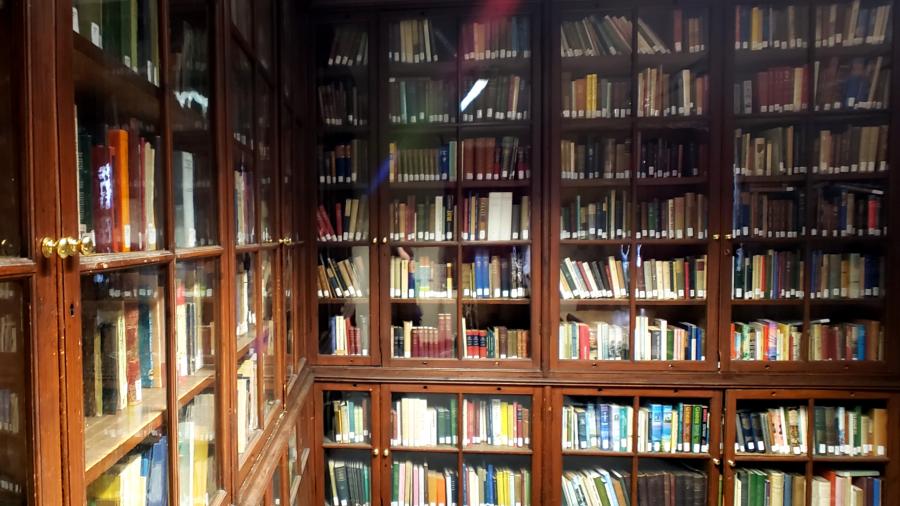
.
Publication date: 16 November 2017
Funding award for 'The Arthurian Quest' project

A new impact-generating collaborative project on the topic of ‘The Arthurian Quest’ has been awarded funding from the ESRC Bangor University Impact Accelleration fund. Prof. Raluca Radulescu, principal investigator, will work with Gillian Brownson, local creative practitioner, and Kate Stuart, MPhil student in the School of Creative Studies and Media, on a programme designed to raise levels of engagement and literacy among secondary school pupils in the local area.
Publication date: 24 October 2017
Blog Post by Casey Harris, MA candidate, University of Villanova, USA, first resident short-term fellow of the Centre for Arthurian Studies, July 2017
The month I spent as a visiting research scholar at Bangor University was invaluable in laying the groundwork for my MA dissertation. I am a student at Villanova University, and my dissertation concerns Geoffrey of Monmouth’s Historia Regum Brittaniae, and emerging notions of just warfare during the twelfth century: Bangor University’s wide-ranging collection of medieval authors, along with the university’s extensive collection of modern scholarship on medieval topics, allowed me to survey the topic, gain a better understaning of the context, and to examine more closely multiple twelfth-century sources. Of greatest value, however, was Bangor’s extensive Arthurian collection, the primary reason for my visit: this allowed me ease of access to a number of Arthurian sources that, prior to coming to Bangor, I had found difficult to compile for side-by-side comparison.
A large portion of the progress I made in my research was due to the guidance of the Bangor faculty and staff: during the course of my research fellowship, Prof. Raluca Radulescu commented on several aspects of my work and offered academic mentoring. Additionally, Prof. Radulescu connected me with several other members of the university, including current students and library faculty. These connections allowed me to better identify and utilize those university facilities and research resources that were available to me as a visiting research scholar, and to benefit from the Bangor research culture. Of particular note is Special Collections Co-ordinator, Shan Robinson, who gave me access to several rare Historia Regum Brittaniae manuscripts; introduced me to the library facilities and systems; and provided me with details on Bangor’s specialized Arthurian sources, including the Flintshire, Harries Arthurian Collection.
Blog post by Casey Harris, MA candidate, University of Villanova, US, first resident short-term fellow of the Centre for Arthurian Studies, July 2017
Publication date: 31 July 2017
XXVth International Arthurian Congress in Würzburg, Germany, July 2017
Centre for Arthurian Studies members and affiliated members (staff and students from Bangor University and elsewhere) contributed to the 24th International Arthurian Congress held in Würzburg, Germany this July.
Conference papers were given by Prof. Raluca Radulescu and Emeritus Prof. P. J. C. Field, members of the external board of the centre Prof. Andrew Lynch (University of Western Australia, also newly elected, at the congress, as President of the International Arthurian Society), Prof. Carolyne Larrington (Oxford University) Dr Alan Lupack (University of Rochester), and Dr Samantha Rayner (University College London), as well as by Bangor University PhD and MA students (Audrey Martin and Maurita van Droogenbroek), and a current fellow of the Centre, Dr Rebecca Lyons (University of Bristol).
A special round table organised by Dr Samantha Rayner, member of the external board, and Prof. Raluca Radulescu, director of the Centre, focused on the impact of post-medieval Arthurian texts in their historical and cultural contexts.
At this event Prof. Radulescu showcased the work being undertaken as part of the digitisation programme of the Arthurian collections in Bangor University Library and Special Collections, and in particular the ongoing online exhibition ‘Malory at Bangor and in the World’
Publication date: 10 July 2017
Bangor Arthurian expertise at Bradford Literary Festival this July
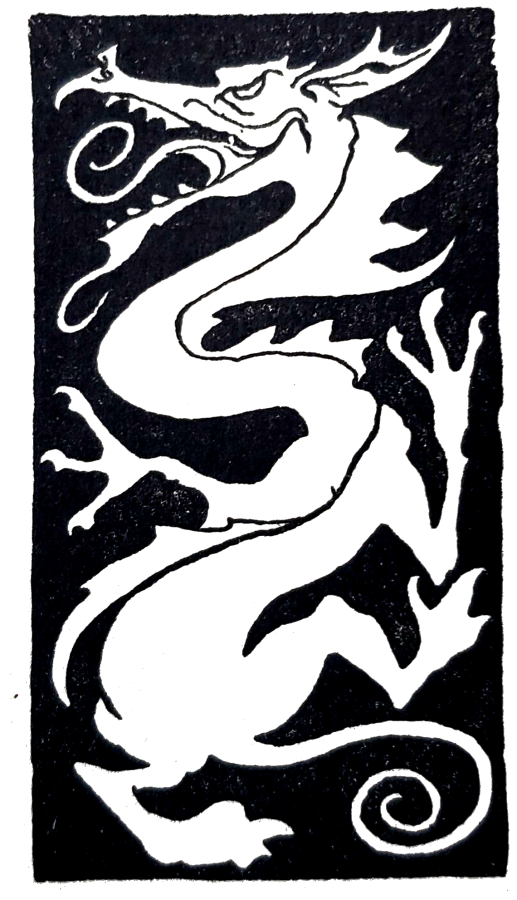
Prof. Raluca Radulescu, director of the Centre for Arthurian Studies, and Emeritus Prof. P. J. C. Field, School of English Literature, will be giving talks to the public on the topic of King Arthur through the Ages and Malory's Arthur in Tennyson's world (Radulescu, 1 July, 11:30am and 5:15pm respectively) and Camelot (Field, talking about his recent discovery of the potential location of the historical Camelot, 1 July, 2:30pm).
Publication date: 19 June 2017
New Arthurian edition by Bangor Emeritus professor

The new edition of the most popular English language story of the legendary King Arthur, Thomas Malory’s fifteenth-century Le Morte Darthur, provides students at all levels and the general public with the authoritative text, but without the extensive critical apparatus, of the recent 2-volume scholarly edition published by leading academic medieval press Boydell & Brewer previously launched at the British branch conference of the International Arthurian Society, hosted by Bangor University and organised by Prof. Raluca Radulescu, the centre's director, in 2013.
This publication event follows the recent presence of Bangor University's Centre for Arthurian Studies at the Bradford Literary Festival, where three out of four events focusing on the Arthurian legends and their retelling featured Prof. Raluca Radulescu, expert panel member on 'The Arthurian Legend and Its Enduring Appeal' and 'The Lady of Shalott: Tennyson's Camelot', and Prof. Field talking about 'Camelot Through the Ages'. The invitations to this prestigious festival came following the quickly expanding news coverage of Bangor University’s Centre for Arthurian Studies, launched in January 2017 to celebrate the university’s long-established tradition in this area of study, and the Year of Legends in Wales.
The organisers of the festival also wanted to showcase Prof. Field’s discovery of the potential location of the historical Camelot, presented in a ground-breaking lecture at the launch of another of Bangor University’s new research centres, the Stephen Colclough Centre for the History and Cultures of the Book in December 2016.
Bangor University's Arthurian staff and postgraduate students will present their research at the XXVth International Arthurian Congress held in Würzburg, Germany (24-29 July), where scholars from across the world will be given a glimpse into the rare Arthurian books in Bangor University's Centre for Arthurian Studies and Library and Archives Collections through a presentation of our online exhibition, curated by Prof. Radulescu in collaboration with Shan Robinson, deputy director of the Centre, the centre's international advisory board, current staff, students and alumni of the MA in Arthurian Literature.
Publication date: 19 July 2017
Prof. Raluca Radulescu awarded a Bangor Teaching Excellence Fellowship

Prof. Raluca Radulescu was awarded a Bangor Teaching Excellence Fellowship at the university graduation in July on the grounds of her achievements in teaching and research supervision in the areas of medieval and Arthurian studies.
Publication date: 17 July 2017
International Arthurian Congress
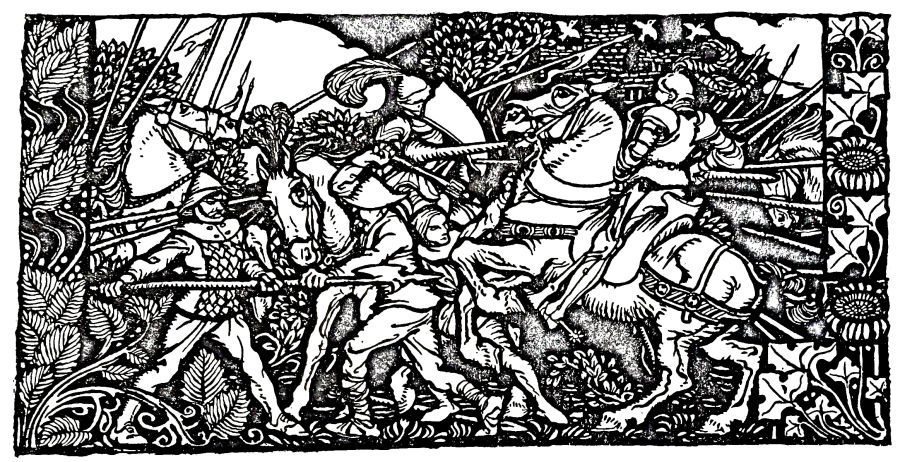
Centre for Arthurian Studies members and affiliated members (staff and students from Bangor University and elsewhere) contributed to the 24th International Arthurian Congress held in Würzburg, Germany this July.
Conference papers were given by Prof. Raluca Radulescu and Emeritus Prof. P. J. C. Field, members of the external board of the centre Prof. Andrew Lynch (University of Western Australia, also newly elected, at the congress, as President of the International Arthurian Society), Prof. Carolyne Larrington (Oxford University) Dr Alan Lupack (University of Rochester), and Dr Samantha Rayner (University College London), as well as by Bangor University PhD and MA students (Audrey Martin and Maurita van Droogenbroek), and a current fellow of the Centre, Dr Rebecca Lyons (University of Bristol).
A special round table organised by Dr Samantha Rayner, member of the external board, and Prof. Raluca Radulescu, director of the Centre, focused on the impact of post-medieval Arthurian texts in their historical and cultural contexts.
At this event Prof. Radulescu showcased the work being undertaken as part of the digitisation programme of the Arthurian collections in Bangor University Library and Special Collections, and in particular the ongoing online exhibition ‘Malory at Bangor and in the World’
Publication date: 10 July 2017
THELMA Awards

The Library and Archive Service of Bangor University have been shortlisted for a prestigious Times Higher Education Leadership and Management Award (THELMA) for their outreach and community engagement work. The projects highlighted for this award included the King Arthur Fun Day / Medieval Fun Day that took place in June 2015 & June 2016. These projects were designed to highlight our Arthurian Special Collection and also to celebrate the founding of the university’s Centre for Arthurian Studies. The first event aimed at families was held at the Main Library in June 2015.
This was so successful, that twelve months later we invited nearly 500 local school pupils and their teachers to Caernarfon Castle to enjoy a packed program full of history, education, creativity and fun.
Activities across both events included workshops on creating a medieval book, creating digital castles, medieval calligraphy and a treasure hunt for the Holy Grail. Both events were delivered in association with the College of Arts of Humanities and the Centre for Arthurian Studies, and were funded by the Widening Access Centre.
The winners will be revealed on Thursday 22 June 2017 at a black tie event at the Grosvenor House Hotel, London.
The Centre for Arthurian Studies would like to wish the Library team the best of luck.
Publication date: 30 May 2017
Arthurian Place Names in Wales: Book Launch
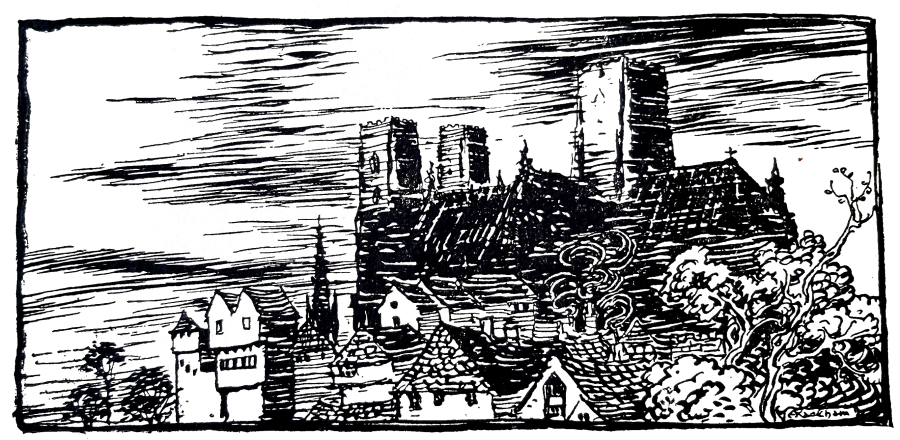
Bangor University’s Centre for Arthurian Studies has recently hosted an event celebrating the publication of Arthurian Place Names in Wales by Scott Lloyd.
By examining a wealth of written sources from the medieval past through to present-day studies, this new book, published by the University of Wales Press, considers a wide range of materials associating King Arthur with sites in Wales. Claims about the identity of Arthur and his kingdom are placed in a wider context, with issues surrounding dating, authorship, impact and influence given due consideration. This exciting addition to the corpus of work about Arthur, also includes a gazetteer of sites - including those whose locations have yet to be identified.
Scott Lloyd is a long-standing collaborator with the School of English Literature at Bangor University. He works for the Royal Commission for Historical Monuments in Wales, and has served on the committee of the British Branch of the International Arthurian Society.
This event was hosted the University’s new Centre for Arthurian Studies, which continues to establish itself as an international hub for research and discussion, bringing together a range of expertise in all aspects of Arthurian studies. Scott Lloyd is involved in a number of collaborative projects organised by the Centre, of which he is a member.
The launch event was introduced by Professor Raluca Radulescu (Director of the Centre) and Dr Aled Llion Jones (Deputy Director). There followed an introductory talk by Emeritus Professor P.J.C. Field (School of English Literature) and then the author gave a fascinating and thought-provoking talk on the findings in his book.
Arthurian books, including scholarly works by Bangor staff as well as rare items from the Special Collections in the Bangor University Library were on display during the event - continuing the Centre for Arthurian Studies participation in the Year of Legends in Wales.
Professor Raluca Radulescu said: “It is a pleasure to host this event, especially as it comes at a time that the Year of Legends in Wales is under way, and a special preview organised by BAFTA Cymru of the new King Arthur movie, directed by Guy Ritchie and shot in nearby Snowdonia, was recently shown in Pontio. The locations of the movie are discussed in Scott's book, and the study of the legends and their many manifestations in Welsh culture and beyond form the core of our unique MA in Arthurian Literature. We look forward to more collaborations to come, and interest in north Wales.”
A podcast of Scott Lloyd's lecture will be posted on the website soon.
Publication date: 16 May 2017
BAFTA Cymru and Pontio to host special preview of King Arthur: Legend of the Sword
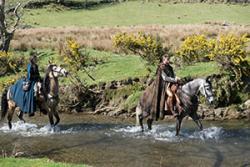
© 2017 Warner Bros. Entertainment, Inc. All rights reserved
BAFTA Cymru and Pontio Arts and Innovation Centre in Bangor, North Wales are proud to announce a very special preview screening of the highly anticipated new epic film KING ARTHUR: LEGEND OF THE SWORD at Pontio’s Cinema at 8pm on Sunday 14 May.
With extensive location shooting in the local Ogwen Valley featuring heavily in Guy Ritchie’s dynamic reimagining of the Arthur legend, this is a fantastic opportunity to see the magic up on the big screen in advance of its official UK release on Friday 19 May, from Warner Bros. Pictures.
Hannah Raybould, Director of BAFTA Cymru said: “The opportunity to offer an advance screening of this highly anticipated feature and to celebrate the use of epic Welsh locations is key to BAFTA Cymru’s role in celebrating the breadth of talented crew and services working on film projects in Wales. It will be a fantastic evening for local industry, our members and the public.”
Starring Charlie Hunnam, Jude Law, Astrid Bergès-Frisbey, Djimon Hounsou, Aidan Gillen and Eric Bana, this new version is an iconoclastic take on the Excalibur myth, tracing Arthur’s journey from the streets to the throne.
When the child Arthur’s father is murdered, Arthur’s uncle, Vortigern (Jude Law), seizes the crown. Robbed of his birthright and with no idea who he truly is, Arthur comes up the hard way in the back alleys of the city. But once he pulls the sword from the stone, his life is turned upside down and he is forced to acknowledge his true legacy.
Cabinet Secretary for the Economy and Infrastructure, Ken Skates, said: “I’m delighted that BAFTA Cymru and Pontio have secured this special preview screening in the area where the film was shot - which is a showcase to Wales’ epic scenery and to our potential as a film location. The release of the film during our Year of Legends is perfect timing as we explore Wales’ many legends and bring the past to life this year. Visit Wales is also partnering with VisitBritain on a digital campaign ‘Where Stories Become Legends’ which showcases legendary locations in King Arthur’s Britain to an international audience.”
Tickets for this special preview available online at www.pontio.co.uk
Publication date: 11 May 2017
The Enchanted Tower: A Week at the Centre for Arthurian Studies
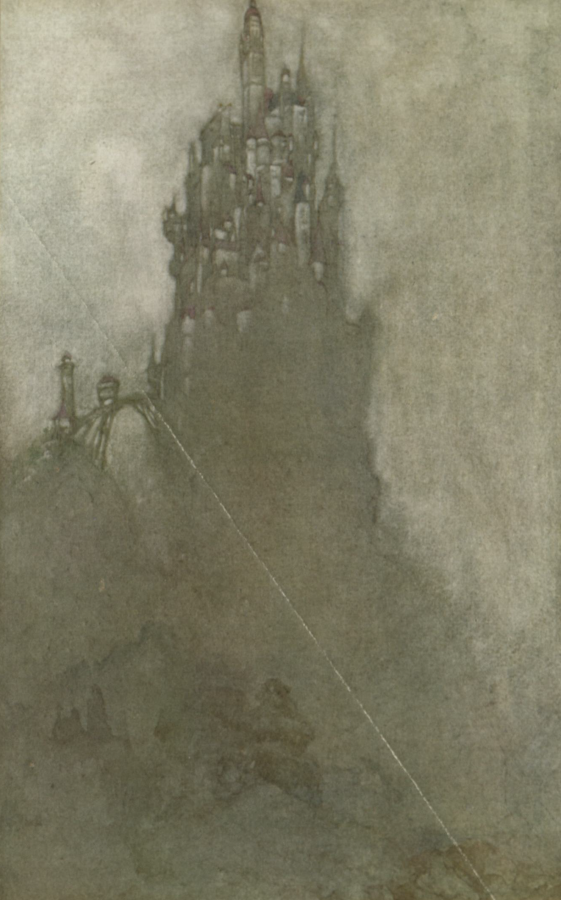
In romance, Lancelot is trapped in a tower by Morgan Le Fay, where he amuses himself by drawing on the walls. In July 2016, I, too, became pleasantly ‘trapped’ in an enchanted tower, where I was in no danger of being bored, as my ‘prison’, located in a tower of the Bangor University Library, was full of books. My week of study was a prize awarded for a post (https://academicbookfuture.org/2016/02/17/iasbb-competition-winner) written for the Academic Book of the Future blog, and it was better than any prize a knight has ever won in a tournament: a week at the newly opened Bangor Centre for Arthurian Studies, with its astonishing collection of Arthurian texts, editions and critical studies.
The terms were simple: after a week of studies, on any Arthurian theme that would catch my fancy, to present a free-form report. The fluidity of the terms was at once liberating and intimidating. I did not know what I would find in the collection, and I was not sure if I was expected to make a ‘discovery’ – or what to report if I failed to do so.
Eventually, I did make a small discovery. I found a spectacular book, which was a poem on Parsifal’s Grail quest, inspired by Richard Wagner, the well-known composer, and, allegedly, unspecified Celtic sources. It was T. W. Rolleston’s, Parsifal or the Legend of the Holy Grail retold from Ancient Sources with acknowledgement to the ‘Parsifal’ of Richard Wagner, presented by Willy Pogany (London: Harrap, 1912). The poem was presented in a limited-edition version, complete with monochrome art nouveau decoration and colour plates, making it nearly as visually impressive as a medieval ‘display copy’ of Arthurian romance. Following my ‘discovery’ the book was included in the virtual exhibition ‘Malory and his Followers’ http://arthurian-studies.bangor.ac.uk/exhibition/bangor/21.php, and I was delighted when, a year later, my research into this text and its illustration was accepted for publication in the Journal of the International Arthurian Society(JIAS) https://www.degruyter.com/view/j/jias.2017.5.issue-1/jias-2017-0007/jias-2017-0007.xml.
Meanwhile, when I arrived at Bangor, I had no action plan, and I could not have possibly prepared one. The collection in the ‘tower’, the Flintshire Harries Arthurian Collection, previously held at the Flintshire County Library, was new not only to me, as it had only been brought to the Centre recently, and I was warned that the paper catalogue might be inaccurate in certain details.
I began with the catalogue and noted some works that I wanted to look at. Then I simply went around the room and browsed the shelves for any books that would catch my eye, based on the title, the author or even the spine. Very soon, a pile of book formed yet another tower on my table: there were works in areas I always wanted to find more about but never had the time, or on the themes that I started to work on and abandoned during my doctoral research, as well as some primary sources that simply looked compelling.
Naturally, I selected far more books than I could read in such a short space of time, let alone study in depth in a week, but even so I continued to add more books to the pile over the next few days. Had I been in Lancelot’s position, I would have gladly allowed to be locked up in the tower; however, the University Library operated on the summer schedule. Despite this slight drawback, I looked through all the books, and made notes on each. I also kept a kind of journal, where I noted the work I had done over the day and any interesting ideas I had, to keep track of where I was.
In fact, my progression was far from linear: like a knight errant, I wandered through the forest of books, and some paths did not lead anywhere. It was only towards the end of the week that I started reading Rolleston’s Parsifal, and I was at once hypnotized by it: the slow cadence of the poetry, and the monochrome decorations and drawings that blazed on every page were and remain very different from the kind of Arthurian literature I was used to: either medieval romances in manuscripts and modern scholarly editions, or modern fiction in paperbacks. Rolleston’s book spoke of a different place, and a different set of cultural values: if it was not a masterpiece, it certainly was beautiful.
The uniqueness of the collection offered at the Centre for Arthurian Studies is that it includes many late-nineteenth- and early-twentieth-century works inspired by Arthuriana, as well as editions and adaptations of medieval Arthurian and Celtic material and scholarly works produced in the same period. In the post-medieval period, Arthurian material was adapted for and read by different audiences, for instance, the ‘general reader’, antiquarians and scholars of literature and folklore. The Arthurian Centre contains examples of these various uses of medieval Arthuriana. To mention but one example, the Bangor University Library and Special Collections hold several early translations and editions of the Mabinogion: William Owen Pughe’s translation, first published in the Cambrian Register in 1795, the first and second editions of Lady Guest’s translation (1838-1849 and 1877), later pocketbooks edited by Alfred Nutt as well as Sidney Lanier’s adaptations The Boy’s Mabinogion (1881) [https://archive.org/details/knightlylegendso00lani].
These and other Celtic sources inspired early-twentieth-century authors, many of whom are little known today: T. W. Rolleston, but also Thomas Evelyn Ellis, who wrote The Cauldron of Annwn (1922).
These editions and adaptations of Arthurian sources, as well as the works of fiction and art they inspired, influenced subsequent generations of readers and scholars and their responses to both Arthuriana and original medieval Arthurian texts. During my week at the Centre, I took this fascinating path of research through a forest of these earlier products of creative work and scholarship produced between the nineteenth century and the first half of the twentieth century: further research by scholars, conducted at the Bangor Centre, will shed new light on the past – and future – of Arthurian literature.
Dr Anastasija Ropa, University of Latvia
Publication date: 1 April 2017
Cataloguing the Arthurian Collection

We reached a milestone this week in the cataloguing of the Flintshire Harries Arthurian Collection when we catalogued the 1,000th book.
We are now halfway through the collection, and the work is progressing steadily.
Thanks to the hard work of the team we are confident that the majority of the collection will be catalogued by the beginning of the new academic year. If you wish to explore the collection, just type “Flintshire Harries Collection” in the search box and choose “Library Search” on the online catalogue.
Publication date: 29 March 2017
How King Arthur became one of the most pervasive legends of all time
This article by Raluca Radulescu, Professor of Medieval Literature and English Literature, Bangor University was originally published in The Conversation. Read the original article.
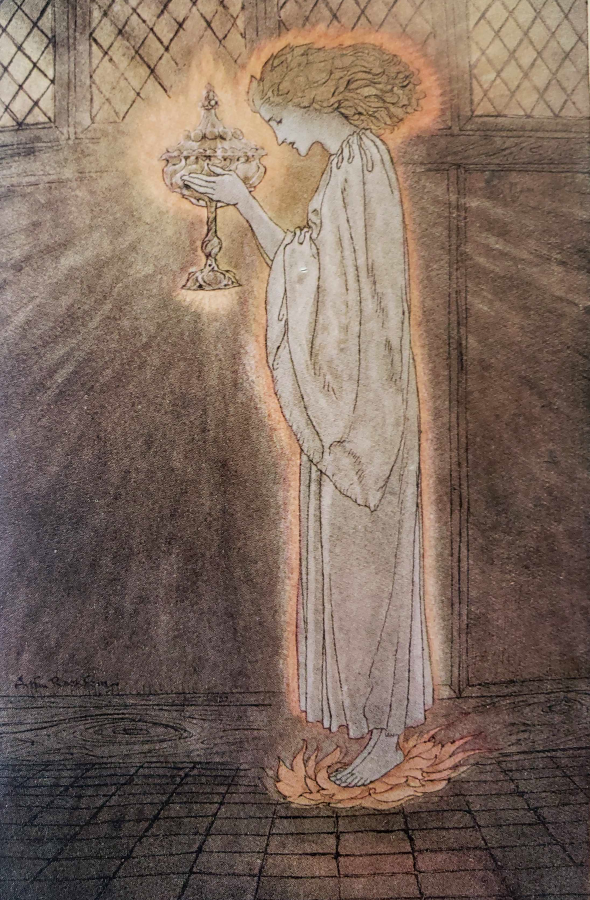
Bangor University Library and Special Collections
King Arthur is one of, if not the, most legendary icons of medieval Britain. His popularity has lasted centuries, mostly thanks to the numerous incarnations of his story that pop up time and time again.
Indeed, his is one of the most enduring stories of all time. Though his tale is rooted in the fifth and sixth centuries, it has continued to captivate audiences to this very day. There is just something about the sword in the stone, the knights of the round table, Lancelot, and the wizard Merlin, that have kept us coming back to the various legends of King Arthur for such a long time.
In the last 15 years alone, there have been Hollywood movies, computer games, and other creative re-tellings. With Bangor University’s new Centre for Arthurian Studies just launched a fortnight ago, and Guy Ritchie’s new movie, King Arthur: the Legend of the Sword, due to be released in late spring, there is no doubt both the scholarly search for Arthur and the impact of his legends on modern culture are continuing to flourish.
Arthur’s life story is one that has become almost a standard for knightly heroes to aspire to. He is seen as brave, noble, kind – everything that some might say is missing from our modern world.
The epic hero
Few might know that Arthur is a hero whose ancestry goes back to the Brittonic inhabitants of early medieval Wales before the arrival of the Saxons, and not just the kingly figure that appears in later romances. In fact, the Arthur of legend was neither a king, nor the owner of a round table, at least not in the way we use these terms today.
Records about Arthur’s life are few and far between. He emerges in the sixth century in the work of the Welsh monk Gildas, where his victory at Mount Badon is celebrated, but he is not named. It is only in the ninth century Historia Brittonum, composed by another monk, Nennius, that Arthur is named as a “dux bellorum”, a military commander, and his 12 battles are listed.
Much time passed between these early records and the 12th century’s full-blown accounts of Arthur’s reign – in the work of Geoffrey of Monmouth and the French Chretien de Troyes, the writers who truly made Arthur the legendary king we now know – and he took on a variety of roles.
In the Welsh stories, Arthur remains a warrior, often a foil for other heroes’ path to greatness. But in the early French romances, he provided a yardstick for courtly behaviour, as epic battles do not form the backbone of these later stories written on the continent. Geoffrey of Monmouth brought back the leadership and determination of an Arthur who becomes not only a king (on whom 12th century Anglo-Norman kings could model themselves), but also a conqueror – again reflecting a desire for greatness beyond national boundaries. Thus the image of the courtly king, a leader in both war and times of peace, was born.

Defeat of Arthur by the Saxons: By John Cassell (Internet Archive) [Public domain], via Wikimedia Commons
However, Arthur was always connected to the realities of those countries, and the times and peoples for whom he was reinvented. The Arthurian revival of the late 19th century, for example, helped put him back on the international cultural map by removing the historical aura, and emphasising the values he stood for – a far cry from the medieval attempts to utilise him as a national figure from whom medieval kings could derive their right to rule. This paved the way to the fantasy worlds created, most famously, by T.H. White in The Once and Future King, published in 1958.
All of these interpretations were about more than just revealing the secrets of one of the most intriguing men of all time. In this confusing and sometimes frightening world, audiences seek reassurance in the models of the past. They want a standard of moral integrity and visionary leadership that is inspirational and transformational in equal measure. One that they cannot find in the world around them, but will discover in the stories of King Arthur.
Is our modern appetite for fantasy a reflection of our need to reinvent the past, and bring hope into our present? Moral integrity, loyalty to one’s friends and kin, abiding by the law and defending the weak, form the cornerstone of how Arthurian fellowship has been defined through the centuries. They offer the reassurance that doing the morally right thing is valuable, even if it may bring about temporary defeat. In the end, virtues and values prevail and it is these enduring features of the legends that have kept them alive in the hearts and minds of so many through the centuries.
Publication date: 3 February 2017
Launch of Bangor’s Centre for Arthurian Studies
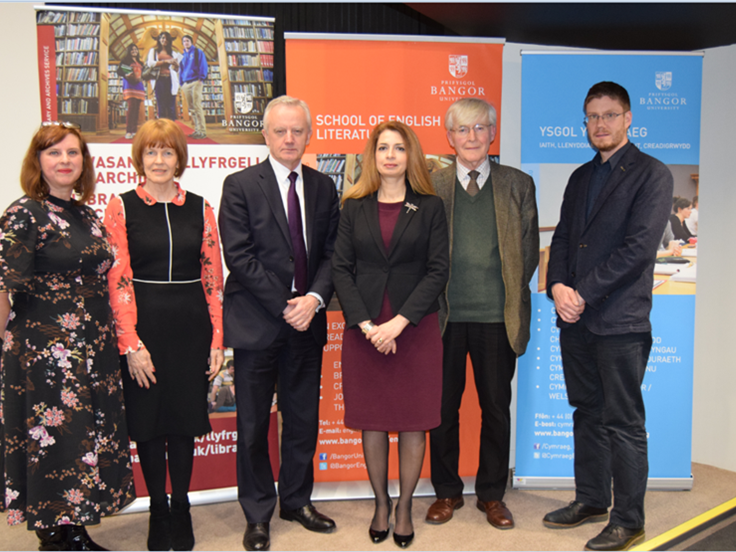
Bangor University is celebrating the start of 2017 with the launch of a new Centre for Arthurian Studies on Friday 20 January, just as Wales begins to celebrate a Year of Legends. Throughout 2017 events will be held at historic sites the length and breadth of Wales in celebration of its rich culture and heritage.
Building on a long-standing international record of excellence in research, teaching and engagement in the area of Arthurian Studies that goes back to the foundation of the University and the University Library in 1884, this new Centre formalises the presence of this important area of study within Bangor University.
According to Professor Raluca Radulescu, ‘The new Centre celebrates more than 100 years of continuous scholarly activity in the areas of Celtic and Arthurian Studies, with particular achievements highlighted by the involvement of Arthurian scholars in the leadership of the International Arthurian Society (of which Emeritus Professor P.J.C. Field was President) and the editorship of the society’s journal’.
Professor Radulescu goes on to say: ‘Bangor University offers the only MA in Arthurian Literature in the world, and Bangor alumni have gone on to international careers in higher education, publishing and librarianship. Bangor University Library’s Arthurian holdings have benefited from the arrival of the Flintshire Harries Arthurian collection in 2015, and we are proud to be at the forefront of a number of local, national and international events focused on the Arthurian legends – as Professor Field’s recent lecture on the location of Camelot has shown.
The Arthurian legends have become so embedded in modern life, culture and politics that associations with the Sword in the Stone through the marketing of Guinness or indeed Camelot as President J. F. Kennedy’s legacy in US politics can sit alongside our use of the phrases ‘round table’ and ‘Holy Grail’ in our everyday language. Nineteenth-century revivals and reinterpretations of the legends are the source of much modern fantasy, though the medieval sources remain a focus of much research and fascination among scholarly audiences and the general public alike. With a new Hollywood movie on the ‘Legend of the Sword’, shot in scenic North Wales, in Snowdonia, to be released later this year, we are well placed to showcase the origins of the stories in medieval Wales.’
The launch event will take place at 4pm in in the Eric Sunderland Lecture Theatre (MALT), Bangor University.
Following introductory remarks by Dr Aled Llion Jones (School of Welsh), on the subject of 'Arthur in Wales – Arthur in Bangor', Emeritus Professor P.J.C. Field (School of English literature) will deliver a brief address - 'Malory's Round Table'.
The main lecture, 'Portable Arthur: Why medieval legends are still relevant to us' will be given by Professor Raluca Radulescu. The founding director of the Centre for Arthurian Studies, Professor Radulescu (School of English Literature) is also President of the British Branch of the International Arthurian Society and Editor of the Journal of the International Arthurian Society.
After the talks, there will be refreshments in the Shankland Reading Room, Main Arts Library, as well as an opportunity to view an exhibition of rare Arthurian books in the Council Corridor and the new online international exhibition of Arthurian materials.
You can find out more about the Centre for Arthurian Studies here.
Publication date: 11 January 2017
Arthurian Studies at Bangor
Arthurian Studies have flourished at Bangor since the founding of the University: a large number of standard works, central to work in the field, have been published by scholars who worked – and who work – here. The information below concerns some of those scholars.
Professor William Lewis Jones (1866–1922)
Professor of English, and University Librarian. In 1891 he was appointed Assistant Lecturer in English at the University College of North Wales and in 1897 became Professor. He took a leading part in raising funds for the new College buildings. He published King Arthur in History and Legend in 1914.
Sir John Morris-Jones (1864–1929)
Sir John Morris Jones was a grammarian, literary critic and poet. Born in Llandrygarn, Anglesey, he was educated in Friars School Bangor. Having been awarded a scholarship to study at Jesus College, Oxford, he was a founder member of Cymdeithas Dafydd ap Gwilym, and graduated in Mathematics in 1887. He returned to Wales and was appointed Lecturer in Welsh here in Bangor in 1889 before being appointed Professor in 1895. He played a central part in the National Eisteddfod, Bangor, of 1902, when the Chair was won by T. Gwynn Jones for his awdl ‘Ymadawiad Arthur’ (‘Arthur’s Departure’) and the Crown by R. Silyn Roberts for his poem ‘Trystan and Esyllt’.
Bedwyr Lewis Jones (1933–1992)
Bedwyr Lewis Jones was Professor of Welsh at the University 1974–92, and championed the use of the Welsh language in all the University’s activities. He was also a prolific lecturer at literary and other societies throughout Wales.
Gwyn Thomas (1936–2016)
Professor Gwyn Thomas was a poet, academic and a former National Poet of Wales. Born in Blaenau Ffestiniog, he was educated at Ysgol Sir Ffestiniog, University of Wales, Bangor and Jesus College, Oxford. He lectured at the School of Welsh from his appointment until his retirement as Professor of Welsh in 2000. In joint ventures with Margaret Jones he three times won the Tír na nÓg award, presented by the Welsh Book Council for the best children’s books: in 1989 he won with his retelling of the oldest Arthurian tale, Culhwch ac Olwen.
Dafydd Glyn Jones
Dafydd Glyn Jones is a Welsh scholar and lexicographer. He spent many years as a lecturer and senior lecturer in Welsh Language and Literature at the Bangor University. He retired from the University in 2000.
Professor P.J.C. Field
Professor P.J.C. Field lectured in the School of English Literature, Bangor University from 1964 until his retirement in 2004. Professor Field was also the President of the International Arthurian Society (2002–2005).
His work on the fifteenth-century romance writer Sir Thomas Malory culminated in his revised edition of E. Vinaver’s The Works of Sir Thomas Malory in 1990. In 2013 Prof. Field published the first full edition of Malory’s text from both the Winchester manuscript and Caxton’s first printed edition, as a result of over 30 years of scholarship.
Professor Peredur Lynch
Professor Lynch is an expert on the Poets of the Welsh Princes and among his many publications on Welsh medieval literature he made a major contribution to Cyfres Beirdd y Tywysogion (’The Poets of the Princes Series’) (Cardiff: University of Wales Press, 1991–96), the groundbreaking critical edition of this extensive body of poetry.
Professor Jerry Hunter
Professor Hunter’s Soffestri’r Saeson (2000) is an investigation into prophecy, historiography and nationalism during the Tudor Age, short-listed for the Wales Book of the Year Award in 2001. He has also published other important works on related aspects of medieval and modern Welsh literature.
Professor Raluca Radulescu
Professor Radulescu is Co-Director of the Institute for Medieval and Early Modern Studies (IMEMS: Bangor and Aberystwyth Universities). She is general editor of the periodical of the International Arthurian Society, Journal of the International Arthurian Society and of the Annual Bibliography of the International Arthurian Society. She has published extensively on Sir Thomas Malory and anonymous Arthurian romances, the Grail, Brut chronicles and political propaganda utilising the Arthurian legends. Her monographs are The Gentry Context for Sir Thomas Malory’s Morte Darthur (2003) and Romance and Its Contexts in Fifteenth-century England: Politics, Piety and Penitence (2013).
Dr Aled Llion Jones
Dr Jones’ recent monograph is concerned with the wider prophetic tradition of the Welsh middle ages, including Arthurian texts. Darogan: prophecy, lament and absent heroes in medieval Welsh literature (Cardiff: University of Wales Press, 2013).
Past Conferences and Symposiums
Members of the Centre for Arthurian Studies, both staff and postgraduate students, will be presenting at this conference, to be held at the University of Birmingham in September 2018. The Centre sponsors one of the sessions, and External board member Dr Samantha Rayner (UCL) will present some of her findings from her research in the Archives of the International Arthurian Society, now placed in the custody of the Centre.
Building on a portfolio of long-standing international research collaboration, and sponsored by IMEMS (Institute for Medieval and Early Modern Studies, Bangor University and Aberystwyth University), the Centre for Arthurian Studies’ day symposium, ‘Chwedlau Arthur yng Nghymru a thu Hwnt / Arthurian Legends in Wales and Beyond’, took place on Thursday 28 June 2018
Read the full blog post.
View the gallery.
Held once every four years, the Congress provides a forum in which experts from across the full range of Celtic Studies — including literature, linguistics, history, archaeology, musicology and art history — come together to share the fruits of their work. Visit the conference website.
A session on animals and material culture in Arthurian studies is co-sponsored by the Centre in collaboration with Dr Renée Ward (University of Lincoln, UK) and Dr Melissa Ridley-Elmes (Lindenwood University, US)
Movement through Arthurian Legend Plenary Speaker: Dr Aisling Byrne 18-10 September 2020 – on-line
Publication date: 10 September 2020

